Our Services
- Chat with a Vet Online

Sick Pet Care and Diagnostics
- Allergies and Dermatology
- Pet Pain Management
- Orthopedic Examination
- Neurological Examination
- Electrocardiogram (ECG)
- Pet Ultrasound
- Veterinary Diagnostic Imaging
Wellness and Preventative Care
- Wellness Exam
- Puppy and Kitten Wellness
- Nutritional Consultation
- Behavioral Consultation
- Vaccination
- Microchipping
Travel Certificates
- Domestic Travel Certificate
- International Travel Certificate
Surgical Procedures
End-of-life care.
- In-Home Pet Euthanasia
- Quality-of-Life Consultation
Our Locations
- Philadelphia
- Washington, D.C. Area
- Conejo Valley
- Greater Los Angeles
- Orange County
- San Francisco
- How It Works?
- Our Veterinarians
- Referral Program
Pet Health Care Resources
- Pet Health Care
- Pet Nutrition
- Pet Symptoms
- Pet Conditions
- Pet Diseases
- Pet Medications
- Pet Lifestyle
Tools, Calculators & Calendars
- Pet Wellness Tools
- Pet Holidays and Awareness Days
Customer Support
- Help Center
- Code of Conduct

Cat Dental Care: Keeping Your Cat's Teeth Clean
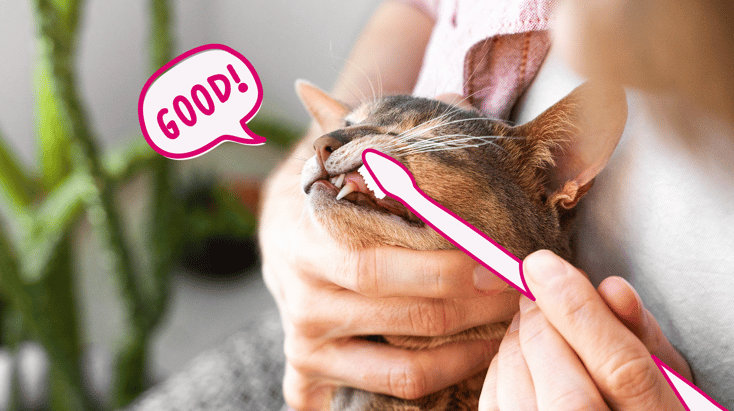
Table of Contents
Do Cats Need Dental Cleanings? How Often Should Cats Have a Dental Cleaning? Importance of Cat Dental Health Identifiers of Healthy Cat Teeth How Often Should You Brush Your Cat's Teeth? How to Brush Your Cat's Teeth Effectively Common Dental Problems in Cats
Every time your feline friend graces you with a contented purr, have you ever paused to think about the health of those pearly whites behind their whiskered grin?
Just like us, our cats need dedicated dental care to keep their smiles bright and their overall health in check.
Key Takeaways:
- Regular dental care for cats, including check-ups and brushing, is crucial to prevent common oral health issues.
- Early detection of dental problems, from periodontal disease to oral tumors, ensures timely intervention and better health outcomes.
- Using vet-approved dental tools, like cat-specific toothbrushes and toothpaste, enhances the effectiveness of your cat's oral care routine.
Dive into our comprehensive guide on cat dental care, where we unravel the mysteries of feline oral health, from common dental issues to effective toothbrushing methods.
Let's get started.
Do Cats Need Dental Cleanings?
Absolutely, cats do benefit from dental cleanings . Just like in humans, dental health is a crucial aspect of a cat's overall well-being. Over time, plaque and tartar can build up on a cat's teeth, leading to gum disease, tooth decay, and other dental issues.
Regular dental cleanings, performed by a veterinarian , can prevent these problems and ensure your feline friend maintains a healthy mouth. Additionally, during these cleanings, vets can identify and address potential dental issues before they become more severe.
How Often Should Cats Have a Dental Cleaning?
Depending on the cat's dental health, professional cleaning may be recommended every 1-2 years . Cats prone to dental issues or with a history of dental disease might require more frequent cleanings.
Pet Dental Health Quiz
1. how often do you brush your pet’s teeth at home, 2. what color are your pet’s teeth, 3. when you look at your pet’s gums, which best describes what you see, 4. when you check your pet’s teeth, what do you see, 5. how does your pet respond to having their teeth or mouth touched, 6. when my pet eats, they:, 7. when you kiss your pet you notice…, view results, grading your pet’s dental health, importance of cat dental health.
Keeping your cat's teeth and gums healthy is crucial for their overall well-being.
Proper dental care in cats:
- Prevents pain, making eating easier.
- Reduces the risk of bacteria entering the bloodstream, which can affect vital organs.
- Avoids bad breath and tooth loss.
- Minimizes the chance of abscesses.
- Ensures a happier, more comfortable life for your cat.
Prioritizing dental health today can prevent severe health complications for your feline in the future.
Identifiers of Healthy Cat Teeth
In order to tell if your cat needs dental care, we need to know what the expectations of a healthy set of cat teeth look like.
Here are some identifiers of healthy cat teeth :
- Clean, White Teeth: Healthy cat teeth should be predominantly white, without excessive yellowing or discoloration.
- Pink Gums: The gums should be a consistent pink color. Red or white patches, or swollen gums, can be signs of issues.
- No Bad Breath: While cat breath won't smell minty fresh, it shouldn't be overly foul-smelling. Persistent bad breath can indicate dental or gastrointestinal problems.
- Absence of Tartar and Plaque: Healthy teeth won't have significant brownish tartar buildup or visible plaque.
- No Broken or Missing Teeth: Healthy dental structures mean teeth are intact without noticeable cracks, chips, or missing elements.
- Comfort While Eating: A cat with healthy teeth will eat comfortably without showing signs of pain or discomfort.
- Absence of Drooling: Excessive drooling can be a sign of dental issues or oral pain.
Regularly checking your cat's mouth and being aware of these identifiers can help ensure that any dental issues are caught and addressed early, promoting long-term dental health for your feline friend.
Keep reading : 11 Signs Your Pet Needs to See a Veterinarian
How Often Should You Brush Your Cat’s Teeth?
For optimal dental health, it's recommended to brush your cat's teeth daily . Regular brushing helps prevent the buildup of plaque and tartar, which can lead to gum disease and other dental issues. If daily brushing isn't feasible due to your cat's temperament or your schedule, aim for at least 2-3 times a week.
How to Brush Your Cat’s Teeth Effectively
Brushing your cat's teeth might seem like a daunting task, but with the right approach and tools, it can become a seamless part of your pet care routine.
Here are some steps to effectively brush your cat’s teeth at home:
1. Choose the Right Tools
Opt for a cat-specific toothbrush with soft bristles. Finger brushes can also be a good choice for some felines. When it comes to toothpaste, always select one made specifically for cats, often available in flavors like poultry or fish. Human toothpaste can be harmful to cats, so it's essential to avoid it.
2. Start Slowly
Before diving into brushing, let your cat get a taste of the toothpaste. This familiarization can make them more receptive. Additionally, allow them to sniff and investigate the toothbrush, building their comfort level with the new tool.
3. Pick a Calm Time
Timing is crucial. Choose a moment when your cat is naturally relaxed, perhaps post-playtime or after a meal. A quiet, distraction-free environment will make the process smoother for both of you.
4. Position Your Cat
Hold your feline friend securely in your lap or place them on a non-slip surface. It's best to approach from the side rather than head-on, making the experience less intimidating for your cat.
5. Brushing Technique
Begin with the front teeth, using a gentle circular motion, and progressively move to the back teeth. The gum line is a hotspot for plaque, so pay special attention there. While it's ideal to brush both the inner and outer surfaces, focusing on the outer is fine since that's where most tartar accumulates.
6. Duration
Aim to brush for about 30 seconds on each side of your cat's mouth. If at any point they seem stressed or agitated, it's okay to pause and continue later.
7. Reward and Praise
Positive reinforcement goes a long way. After each session, offer some form of reward, whether it's praise, a treat, or a bit of playtime. This can make future brushing sessions something your cat might even look forward to.
8. Consistency is Key
Establishing a routine is beneficial. Aim to brush at the same time and in the same place, creating a sense of familiarity and routine for your cat.
9. Monitor Dental Health
Regularly inspect your cat's teeth and gums. Look out for signs like redness, swelling, or unusually bad breath. If anything seems off, it's a good idea to consult with your veterinarian.
With these steps, you'll be well on your way to ensuring your cat maintains optimal dental health.
Common Dental Problems in Cats
Proper dental care for cats is just as important as for humans. By not brushing your cat’s teeth regularly or scheduling a dental cleaning appointment, they can fall prey to some problematic tooth and gum concerns.
The most common dental problems that affect cats are:
- Periodontal Disease : This is one of the most common dental issues in cats. It involves inflammation and infection of the tissues surrounding the tooth. Over time, plaque and tartar buildup can lead to gum recession, tooth loss, and even bone loss.
- Gingivitis: This refers to the inflammation of the gums. It's often the first stage of periodontal disease. If left untreated, it can progress and lead to more severe dental problems.
- Tooth Resorption: Also known as feline odontoclastic resorptive lesions (FORLs) , this condition involves the erosion of a tooth, starting at the enamel and progressing to the inner layers. It's a painful condition, and the exact cause is still not entirely understood.
- Stomatitis: This is a severe and painful inflammation of the mouth's soft tissues, including the gums, cheeks, and throat. The exact cause is often unknown, but it's believed to be an immune system response to plaque or other factors.
- Tooth Fractures: Cats can break their teeth, especially the long canine teeth, due to trauma or chewing on hard objects. Broken teeth can expose the sensitive inner pulp, leading to pain and infection.
- Oral Tumors: While less common than other dental issues, cats can develop growths or tumors in their mouths. These can be benign or malignant, so any unusual lump or bump in a cat's mouth should be checked by a veterinarian.
- Bad Breath (Halitosis): While not a disease in itself, persistent bad breath can be a sign of underlying dental or gastrointestinal issues.
Keep reading: Common Diseases in Cats
Regular dental check-ups and a proactive approach to oral care can help catch and address these issues early, ensuring your feline friend maintains a healthy mouth throughout their life.
Summing Up Cat Dental Care
Maintaining the dental health of your feline companion goes beyond just a bright smile. Healthy teeth and gums are vital for a cat's overall well-being. Unaddressed dental issues can lead to pain, making it difficult for cats to eat.
Moreover, bacteria from dental diseases can enter the bloodstream, potentially affecting vital organs like the heart, liver, and kidneys. Regular dental care prevents bad breath, tooth loss, and the risk of abscesses.
By prioritizing your cat's dental health, you're not only ensuring their comfort but also reducing the risk of more severe health complications down the line. Remember, a proactive approach to dental care can lead to a happier, healthier life for your feline friend.

Written by Dr. Joshua Montgomery

Medically reviewed by Laura Fontana, DVM
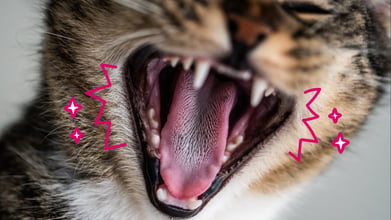
Tooth Resorption in Cats: What You Need to Know

How to Treat Dental Pain in Dogs: 8 Ways

Dental Care for Dogs: 4 Ways You Can Help
- Monday - Friday: 8:00am - 6:00pm
- Saturday & Sunday: CLOSED
- (225) 228-1039
- [email protected] We only answer this email Monday-Friday. If there is an emergency refer to our emergency page .

Dental Care For Cats

What is Proper Dental Hygiene for Your Cat's Teeth?
There are several ways to ensure proper cat dental care. All of them involve diligence and commitment from you as a cat owner. Your feline friend will not tell you if they need dental care, so it is up to you to proactively address their needs.
- Good nutrition is the foundation for good dental health.
- When possible, establish a cat teeth cleaning routine when your cat is young - ask us about our Veterinary Oral Health Council accepted products! Brushing is the gold standard of home dental care, but there are many other dental hygiene products available if brushing does not fit your lifestyle.
- Schedule semi-annual exams for cats, or at the recommendations of your veterinarian.
- Watch for signs of possible dental issues, such as bad breath.
- Tell your veterinarian during their checkup about any behaviors you've noticed or concerns you have (chewing on odd objects, pawing at the mouth, anorexia, among others)
- Early prevention is essential to minimize serious dental issues.
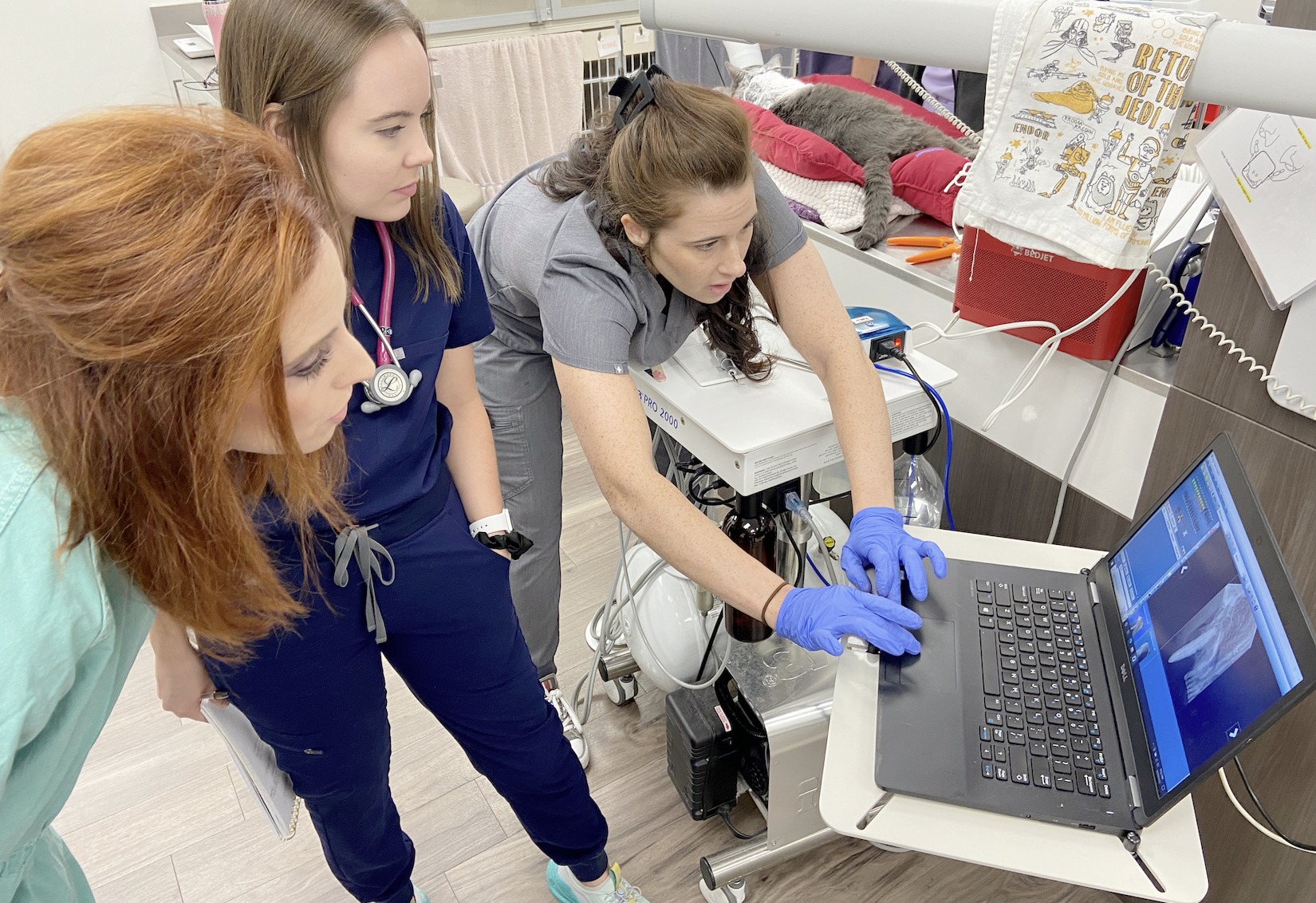
Other dental issues in cats include gingivitis and periodontal disease that may require medication and/or dental work to alleviate the pain . The importance of annual exams cannot be understated! In order to remain healthy, dental care is something you should trust to your veterinarian.
Featured Quote:
Video transcript:.
Hi, my name is Lacie Lee and I'm a feline veterinarian at the Cat Care Center of Baton Rouge. Did you know that February is Pet Dental Month? Here at the Cat Care Center, we are going to do a series of videos answering your questions on feline dental health.
Does my cat need yearly dental cleanings?
We know that oral disease can significantly affect the welfare of our cats as well as their longevity. We also know that their mouths can be a source of bacteria and that this can, in turn, make it difficult to manage some of the other diseases that they may get. Thankfully, in veterinary medicine we have governing boards that put out guidelines, and those guidelines help us better serve you and your favorite felines. The American Animal Hospital Association and the American Association of Feline Practitioners have guidelines on dental disease in cats. According to AAHA - or the American Animal Hospital Association - all kittens and new adult cats need to have thorough oral cavity exams. These also need to happen consistently at every examination thereafter.
What do we look for on your kitten’s first visit?
I'm looking at the way kittens’ teeth line up. Do they line up well? Do I see any gum diseases? Do I see any missing teeth? I'm looking for the same thing in my adult cats. According to the American Animal Hospital Association, by the time a cat is one year of age, he or she should have had a first dental cleaning. This is an anesthetized procedure that includes scaling, polishing, and full oral radiographs to determine where the cat’s oral health lies. And statistically, 70 percent of cats already have significant periodontal or oral cavity disease by the time they’re three years old.
How do we examine cats’ mouths without causing anxiety?
Here at the Cat Care Center, we are a Gold Status Cat Friendly Practice. That means that we do all of our things according to what's best for our cats. And sometimes what's best for our cats is to get a good oral cavity examination using mild sedation. That’s okay because we don't want their veterinary experience to have any negative associations.
This is LM. LM is very nervous for her oral cavity exams. So what we're going to do is have my technician Sandy with me to offer her treats. And when I do an oral cavity exam on the cat, I do my best to avoid pulling whiskers and lips.
As a feline veterinarian, I've learned over the years that you have to be quick when you're looking at the oral cavity of a cat. Again, coming from behind, you have to ask the cat to let you gently lift. We reward her and give her breaks.
I don't want to grab cats’ heads. I want to be as gentle as possible, giving them scratches to let them know they’ll be okay. I do have to get a peek, though, so I gently touch right below their cheekbones. And oftentimes if you tilt the nose up, you can see all the way to the back of her oral cavity into the caudal fossas back there to see if there's any inflammation. My eyes have been trained to be quick for the sake of the cat. And then we'll do a thorough oral cavity examination when she comes in for her dental cleaning and procedure, and that's where a little bit of anesthesia is involved. At that point, we'll get a really good look at those teeth and a good look below the gumline.
I hope you guys enjoyed the first video. Thanks for watching. Check out our website, www.catcarecenter.com . Under the service tab cat dentistry, you'll find a bunch of information, much of which I went over today.
How Often is it Necessary to Have My Cat's Teeth Cleaned Professionally?
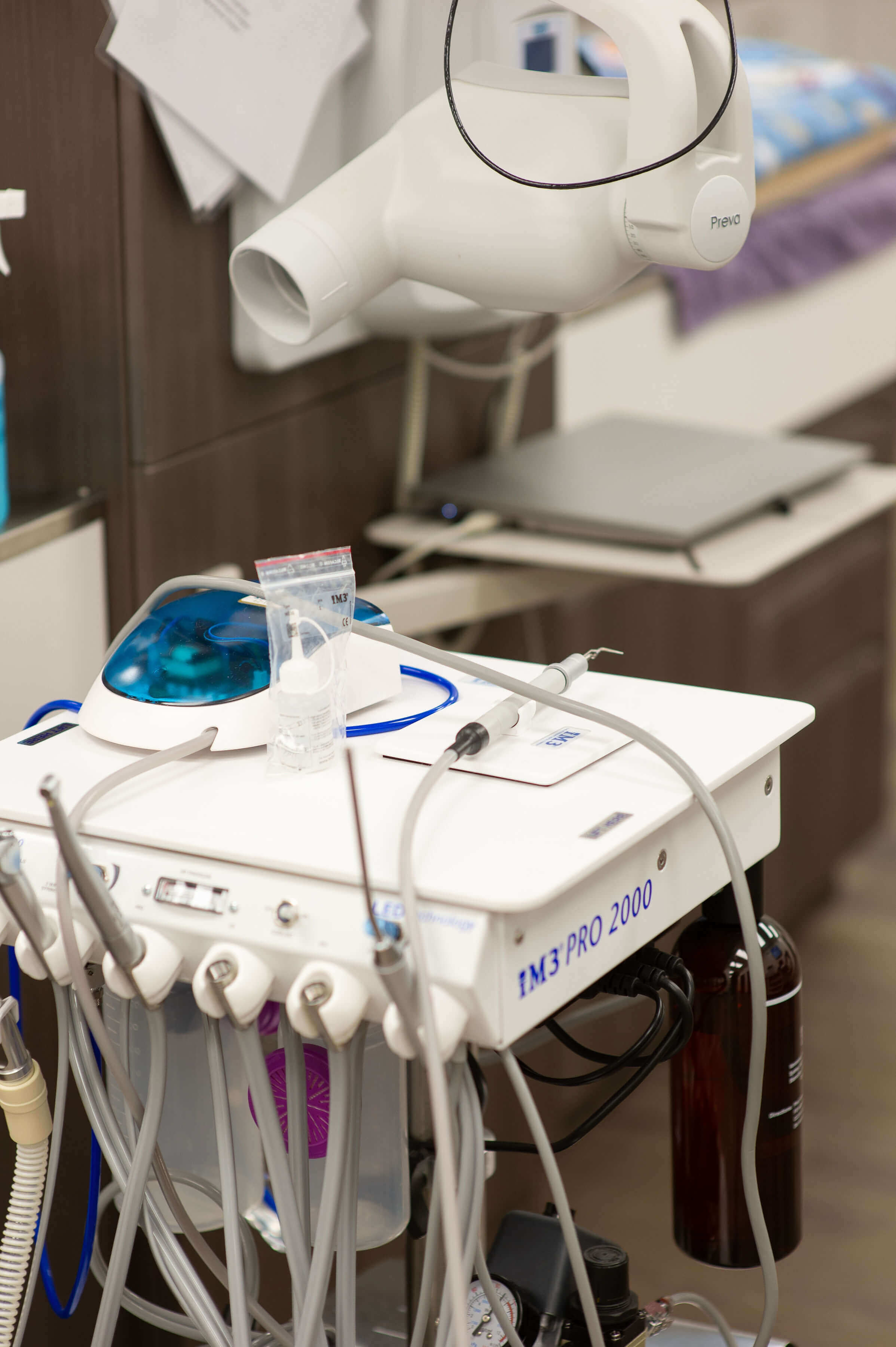
- Existence of other health conditions
However, regardless of signs or symptoms, your cat should have a dental checkup annually at a minimum. While you should be looking at your cat's teeth periodically yourself, it is easy to miss the types of problem signs that a trained and experienced veterinarian will pick up on. It is significantly easier to address and resolve dental issues that are spotted early, compared to dental issues that go unnoticed and are allowed to further develop. Therefore, a proactive approach to feline dentistry is recommended.
Click here to call and make a dental appointment today! Our technicians will work with you and your cat from the time of your appointment all the way to recommending products to use at home. One of the best preventative care regimens you can perform is tooth brushing. Watch the following informational video to learn how to brush your cat's teeth in a feline friendly manner! Remember - don't use human toothpaste or baking soda on your furry friend.
Cornell University: Brushing your Cat's Teeth
Gum Disease in Cats
Gum disease, also known as gingivitis, can become periodontal disease if it spreads into the tooth. These conditions affect a cat's gums and the portion of their teeth below the gum line and may include feline resorptive lesions. Periodontal disease is considered the most prevalent illness in cats over three years of age. However, it is also the most under diagnosed, because many cat owners unfortunately do not realize the importance of cat dental care! Although detection of cat gum disease can be subtle, periodic veterinary checkups every 6 to 12 months can be vital in helping diagnose cat gum disease before it becomes severe.
Gum disease has four stages:
- Early gingivitis
- Advanced gingivitis
- Early periodontitis
- Established periodontitis
Gum disease in cats is only reversible if caught early on, and only the early gingivitis stage is considered fully reversible. Therefore, it is your responsibility to keep your cat's mouth, teeth, and gums healthy and well.
Cat Tooth Extraction
Cat tooth extraction is necessary in several cases, including advanced stage gum disease. Advanced periodontal disease can cause loss of viable teeth. The teeth that are severely affected should be extracted before they lead to bone infections and tooth abscesses.
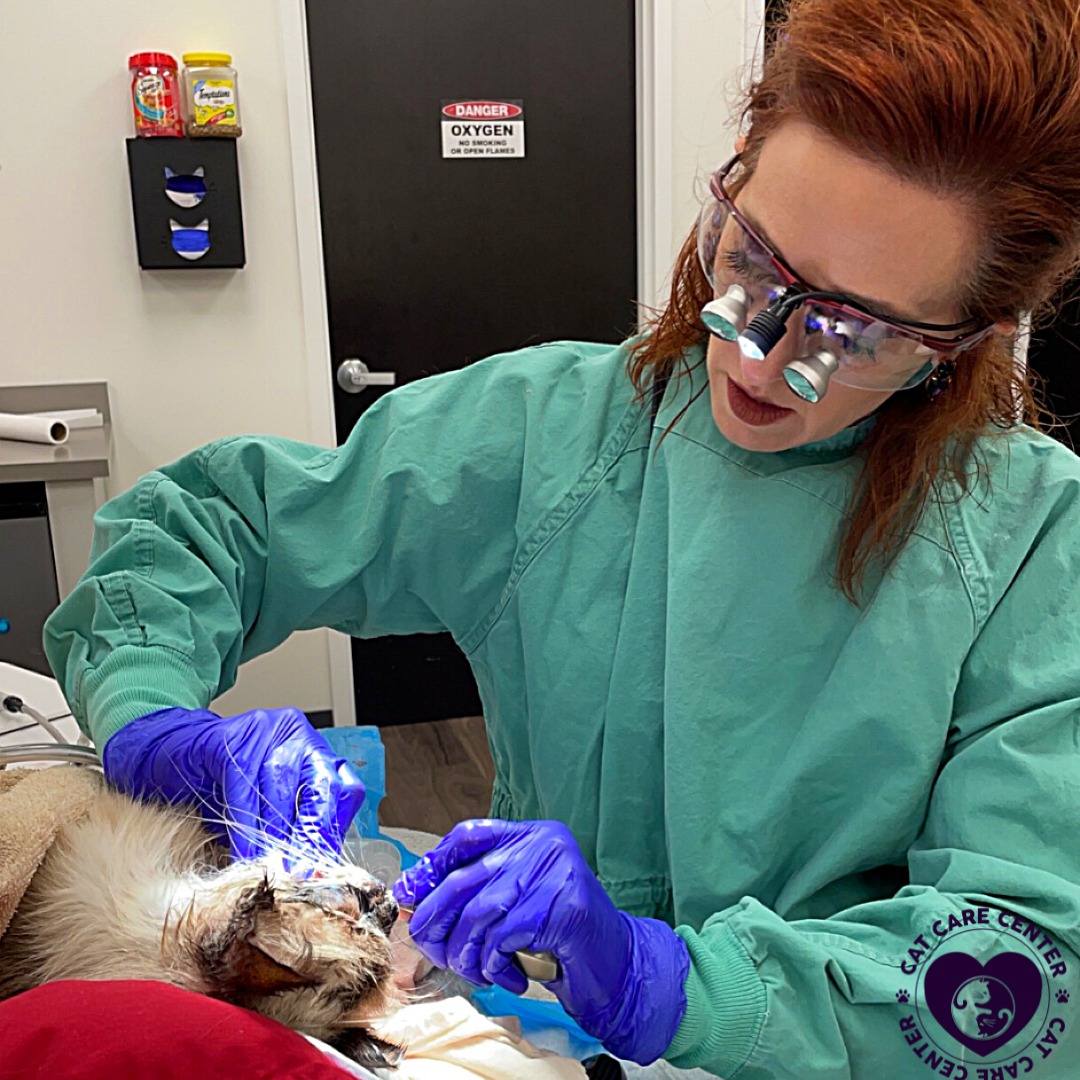
- Retained deciduous or maloccluded teeth.
- Teeth that are severely infected are always considered for extraction
- Cats that suffer from root abscess or jaw fractures may be treated with tooth extractions based on the severity
The cost of cat tooth extraction is based on the type of procedure performed, and may include hospitalization, anesthesia, pain medication, x-rays, oral surgery, and surgical supplies. At Cat Care Center, Dr. Lacie and the veterinary team understand the unique dental needs and diseases affecting cats. From state-of-the-art dental equipment to intra-oral radiograph capabilities and continuous training in feline dentistry, we are equipped and prepared to offer a unique feline experience. We will walk you through your cat's experience the day of their procedure, communicate during their time with us, and go over at-home care.
Common Cat Dental Problems
- Plaque build-up
- Periodontal disease
- Mouth sores and ulcers
- Feline Resorptive Lesions
- And, like in humans, kidney, liver, and heart disease
Cats are very adept at hiding symptoms of pain and illness. Bad breath is the only symptom of dental problems that you are at all likely to observe in your cat. If your cat has noticeably bad breath, you should schedule an exam with your veterinarian. However, in severe cases you may also notice one of the following symptoms:
- Pawing at the mouth
- Problems eating, loss of appetite
- Red, swollen, bleeding gums
- Loose, broken, missing teeth
- Blood in saliva or nasal discharge
- Lesions in mouth
Your cat may very well have dental issues that require attention and not be showing any of the symptoms listed above. However, if any of the above symptoms are observed, please schedule a veterinary appointment right away.
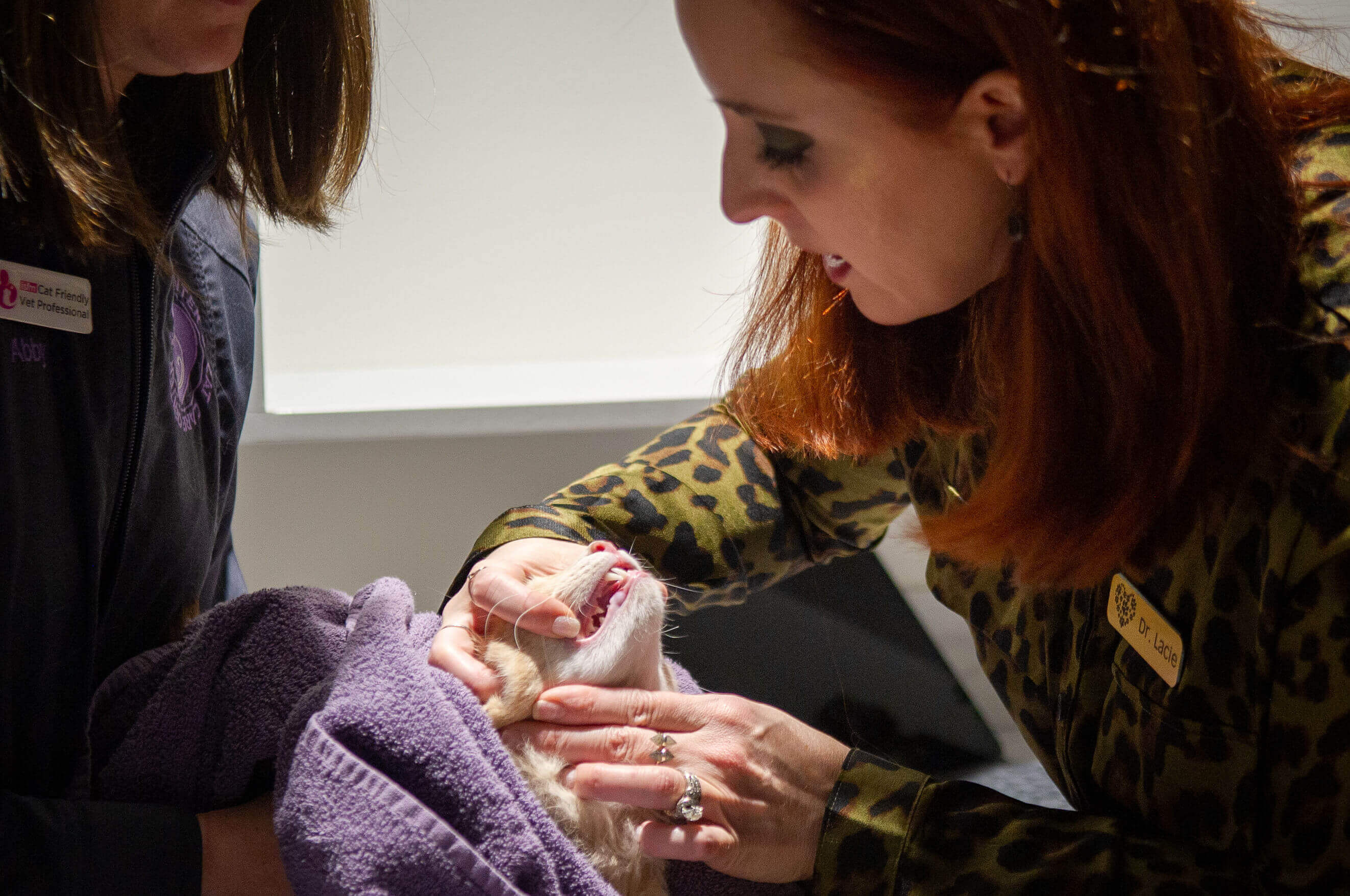
Schedule a Cat Dental Care Appointment
Scheduling a cat dental care appointment is as easy as picking up the phone or sending us an email. Our staff is here to help make your cat's trip to the dentist easy for you, while making it as painless and comfortable for your feline friend as possible.
Refer to our handouts about Cat Oral Pain and Resorptive Lesions.

How to Care for a Cat with Dental Problems

Author TB Thompson DVM has been a licensed, practicing veterinarian since 2000.
Dealing with your cat’s dental disease starts with professional veterinary care. While it can be worrisome, timely treatment – often involving anesthesia and tooth extractions – significantly improves your cat’s quality of life, outweighing the risks and costs.
- Most cats suffer from periodontal disease which requires professional treatment.
- Signs of dental disease include bad breath, swollen gums, and eating changes.
- Preventive care including daily brushing, special diets, and vet check-ups is key for dental health.
Periodontal Disease is a Common Cat Problem
Did you know that periodontal disease affects over 70% of cats? ( 1 )
This condition starts with plaque – a mix of bacteria and food debris on teeth. Without treatment, plaque turns into tartar, causing gingivitis (inflamed gums). Gingivitis can then progress to periodontitis, a serious stage that irreversibly damages the gums and bones around the teeth.
Cats are good at hiding pain, so they might not show obvious signs of dental problems.
As a veterinarian, I often see how this painful condition goes unnoticed by cat owners. The best treatment includes anesthesia. This will allow for a thorough dental check, x-rays and tooth extractions if needed. Although some owners worry about anesthesia, the risks are low compared to the huge improvement in your cat’s life after treatment.

Recognizing the Signs of Dental Disease in Cats
Identifying dental issues in your cat early can make a huge difference in their treatment and recovery. Here are key signs to watch for:
- Bad Breath : While a bit of ‘cat breath’ is normal, excessively foul breath can be a sign of dental disease.
- Red or Swollen Gums and Lips : Look for any redness or swelling in the gums. These can be early signs of gingivitis or occasionally oral tumors . You may also see lip inflammation .
- Changes in Eating Habits : If your cat is suddenly hesitant to eat, especially dry food, or seems to chew awkwardly, it could indicate oral pain.
- Pawing at the Mouth : Cats with dental discomfort may frequently paw at their mouth or rub their face against objects.
- Visible Tartar on Teeth : Tartar, a yellow or brown coating on the teeth near the gums, is a clear indicator of dental issues.
- Drooling : Excessive drooling, especially if it’s tinged with blood, can be a sign of oral pain or dental disease.
- Weight Loss or Poor Condition : In severe cases, dental pain can lead to weight loss or a decline in overall condition due to reduced food intake.
Remember, cats are masters at hiding pain, so even subtle changes in behavior are worth noting. If you notice any of these signs, it’s time to consult your vet for a thorough dental check-up. Early detection and treatment can prevent more serious complications.
Vet Care for Cats with Dental Disease
This section describes the most common routines when cats receive dental treatment from a veterinarian. Knowing what your cat will experience can help calm your anxieties. Here’s what the process typically involves:
Pre-Procedure
- Drop-Off : You’ll drop your cat off at the vet clinic the morning of the procedure. Your cat needs to be fasted to lower the risk of vomiting while anesthetized.
- Health Check : The vet conducts diagnostic tests and a physical exam to identify any undetected health problems.
During the Procedure
- Anesthesia Plan : The vet formulates an anesthesia and dental treatment plan.
- Mouth Examination : Under anesthesia, the vet conducts a thorough examination of the cat’s mouth.
- Dental Radiographs : X-rays are taken to assess the dental condition accurately.
- Dental Work : This may include extractions, treatments for specific oral issues, plus cleaning and polishing of teeth. This part may take anywhere from half an hour to several hours depending on your cat’s dental condition.
- Recovery from Anesthesia : After the procedure, your cat is carefully monitored as it wakes up from anesthesia.
Post-Procedure
- Home Recovery : Once fully recovered, your cat can go home. They might be groggy for 6-24 hours but usually return to normal soon.
- Medications : The vet may provide antibiotics or pain medication, along with special care instructions.
- Follow-Up : You’ll be advised on when to bring your cat back for a recheck and when to start home dental care.
Each veterinary clinic has a unique approach to dental procedures. Ask for a review of the treatment and what to expect afterward.
One Cat Caretaker’s Experience with Dental Care
Maybe you can relate to a story shared by one of our readers about their 9-year-old cat.
Initially, this cat caretaker dismissed a mouth sore and bad breath as normal aging signs. But a vet visit revealed several hidden problems, including severe tartar build-up and tooth resorption. The cat was anesthetized, radiographed and had her teeth cleaned. The vet ended up extracting 5 diseased teeth!
Much to the owner’s surprise, after the procedure, the cat’s energy and playfulness remarkably improved. It was only then that they realized how much pain the cat had been in due to dental disease.
This story serves as a good reminder: don’t overlook changes in your cat’s behavior or dismiss bad breath as just ‘cat breath.’ Regular dental check-ups and cleanings are essential.
As the owner learned, “Cat dentistry isn’t a scam! It made a huge difference in my cat’s quality of life.”
Preventive Dental Care for Cats
Effective dental care starts with an anesthetized dental procedure at one year of age, including x-rays and cleaning. After this, regular preventive measures are key to maintaining your cat’s dental health. Here’s a breakdown of recommended practices and products:
Please note that if your cat already has dental disease you should consult your vet before starting any new dental care routine.
For more information on approved dental care products, visit the Veterinary Oral Health Council at VOHC . Regular veterinary check-ups are crucial for early detection and treatment of oral disease.
Share Your Cat’s Story
We’d like to hear your cat’s story in the comments below. It will help other worried cat caretakers know how to recognize dental disease. What were your cat’s symptoms? How were they different after treatment?
How do I know if my cat is in pain from dental disease?
Signs of pain in cats include bad breath, red or swollen gums, reluctance to eat, pawing at the mouth, drooling, and changes in behavior. Many cats don’t show obvious signs of pain. However, it’s common for owners to notice signs of pain relief after their cat’s dental disease is treated.
Will my cat be able to eat if they have teeth pulled?
Yes, cats can eat normally after having teeth pulled, often with pain relief and a temporary soft food diet. Even cats with no teeth can eat with minimal problems!
How much does it cost for a cat dental procedure?
The cost of a cat dental procedure varies, typically ranging from $300 to $1,000+, depending on the complexity and necessary treatments like x-rays, extractions, and anesthesia.
- Lommer, M. J., & Verstraete, F. J. (2001). Radiographic patterns of periodontitis in cats: 147 cases (1998–1999). Journal of the American Veterinary Medical Association, 218(2), 230-234.
TB Thompson DVM is a veterinarian, graduating from the University of Tennessee College of Veterinary Medicine in 2000. With her extensive experience in general practice, emergency hospitals, animal shelters, and house call services, she founded NPHQ Veterinarian to promote animal welfare.
Leave a Reply Cancel reply
Your email address will not be published. Required fields are marked *
Save my name, email, and website in this browser for the next time I comment.
Be a smarter pet parent
Next time, skip the web. Get health tips and wellness advice for your pet straight to your inbox.
- cat parent must-knows
How much does cat teeth cleaning cost?
Cat dental cleaning can range in price based on the state of your cat’s oral health.
— Medically reviewed by Dr. Michelle Diener
Everything we create is factually accurate and biased toward science → meet our team of experts
Dr. Liza Cahn
Updated February 12, 2024
- Factors that affect the cost
- Does pet insurance cover cleanings?
- What to expect during a cleaning
- Why dental health matters
- Cat teeth maintenance
Frequently asked questions
The essentials.
- Cat teeth cleaning can range from $200 to $1,500 — However, anesthesia, additional sedatives, pain medication, dental X-rays, extractions, and treatments are additional costs.
- The frequency of cat dental cleanings varies — Cats can develop gingivitis, periodontal disease, and other oral health problems if plaque isn’t removed regularly by a professional, so cats should see the vet once a year for a wellness exam.
- Keep your cat’s teeth clean between vet visits — Your cat still needs professional teeth cleanings, but be sure to routinely clean your cat’s teeth at home.
The average vet visit for a cat’s dental cleaning can cost anywhere from $200 to $1,500 but could amount to more depending on the state of your pet’s oral health.
In this guide, we’ll cover cat dental cleaning 101: what affects cost, how often you should schedule cleanings, and how to keep your kitty’s breath fresh in between dental visits.
Factors that affect the cost of cat dental care
Routine cat teeth cleaning costs are generally inexpensive; unless a cat has significant dental disease, needs numerous extractions — these cost about $50 per tooth on average — or needs extra care to stay comfortable during cleaning.
Some of the most common factors affecting the cost of a cat dental cleaning include:
- Who’s conducting your cat’s teeth cleaning. A general practitioner will cost less than a board-certified veterinary dentist giving a professional dental cleaning.
- The extent of the procedure. If all your cat needs is a simple tartar scraping, you’ll be looking at lower costs than if they need more dental work like extractions .
- Pre-cleaning prep. Some vet clinics require full X-rays and tests before they proceed with teeth cleaning. This can add a few dollars onto your bill.
- Extras. If anesthesia, additional sedatives, X-rays, IV fluids, or take-home medications are needed, this can also drive up the total cost of cleaning your cat’s teeth.
- Anesthesia. This is necessary for all cat dental cleanings. Much dental disease takes place below the gumline and it’s not possible to conduct a proper cleaning or give X-rays without anesthesia.
- Age and health of the cat. Older cats are more likely to have an excessive amount of plaque buildup, as well as other health issues which can cause the cost to spike.
- The severity of the dental disease. Regardless of age, if the cat’s teeth are in bad condition and have deteriorated significantly, more work will need to be done — which means more fees.
- Geographic location of the clinic. Where you live will drive the cost up or down due to cost of living differences.
Does pet insurance cover cat dental cleanings?
General anesthesia and any necessary treatments can make teeth cleaning for cats seem expensive for pet parents. Unfortunately, even if you have pet insurance for your cat, insurance may not cover preventative teeth cleanings — unless you have a wellness plan add-on.
Be sure to check with your provider on what your insurance plan covers before your pet’s teeth cleaning appointment.
What to expect during a cat’s dental cleaning
At your cat’s annual teeth cleaning, the vet may start with a quick examination before administering anesthesia, beginning the thorough cleaning and inspection process. Common steps to expect during the cleaning include:
- Anesthesia. Cats need anesthesia for all dental care appointments. For simple cleanings, for example a light amount of anesthesia is used to keep the cat asleep, comfortable, and safe — while also keeping the vet safe.
- Plaque removal. Once the cat is asleep, the vet will scale the pet’s teeth to remove plaque and tartar on the teeth, and under the gum line.
- Tooth polishing. They’ll then polish the teeth will help create a smooth surface, making it harder for plaque to form again on the teeth.
- Inspection. Now, the vet will use a periodontal probe to check around the gums for diseases, such as gingival pockets, root exposure, feline odontoclastic resorptive lesions Trusted Source Veterinary Information Network (VIN) Community of veterinarians with up-to-date veterinary information. Go to source , and tooth mobility.
- X-rays. The vet might then perform X-rays to check for underlying problems below the gums and around the tooth roots — such as tooth root abscesses.
- If X-rays and additional treatments are needed, the cleaning may take as little as an hour or far more if there are significant dental issues.
You should schedule professional teeth cleaning Trusted Source American Veterinary Medical Association (AVMA) Not-for-profit organization representing 97,000+ vets. Go to source for your cat on an as-needed basis. During your cat’s yearly wellness exam, a vet will determine if a dental cleaning is necessary.
👉 While you can do checks on your own to look for signs of problems at home, a veterinarian has special tools that can remove buildup that you can’t safely remove on your own or while an animal is awake. Vets will also have the training to spot early signs of disease and begin any treatments.
Why your cat’s dental health matters
Your cat’s bad breath isn’t always due to fish-flavored kitty food. Cats, like humans, are susceptible to oral health problems like gingivitis without regular checkups and care. That’s why it’s important to have your cat’s teeth cleaned regularly.
🚨 Cats are prone to the buildup of tartar and plaque on the teeth as well as feline odontoclastic resorption lesions. Serious dental issues like periodontal disease Trusted Source Cornell University College of Veterinary Medicine Veterinary school. Go to source or gingivitis can happen, and require extra dental care that can cost some serious cash.
The average cost of these common dental issues includes:
- Tooth extraction – $50 to $200
- Tooth root abscess – $300 to $2,000
- Periodontal disease – $500 to $800
- Gingivitis – $50 to $300
Your cat could experience oral pain, inflammation, infections, tooth decay, or tooth and bone loss as a result of missed cleaning appointments. In extreme cases, oral bacteria can enter a cat’s bloodstream, affecting other organs such as the heart, liver, and kidneys.
The price can also range depending on the tooth and number of roots. Regular wellness checkups and dental exams can help with preventative care. If you find yourself in a situation where your cat has a significant dental health issue, it’s always a good idea to consult your pet insurance to see what expenses might be covered.
How to maintain your cat’s teeth between cleanings
Don’t rely just on the annual teeth cleaning appointment to keep your cat’s teeth and gums in good health. Make sure to consider these additional oral care steps at home between cleanings:
- Finger brushing. Brush your cat’s teeth at home once a day with a finger brush. If you use toothpaste, make sure it is a product made specifically for cats. Human toothpaste may contain ingredients harmful to your furry friend.
- Dental chews. If your cat loves treats, you can give them dental chews to help improve oral health. Look for the Veterinary Oral Health Council (VOHC) Trusted Source Veterinary Oral Health Council (VOHC) Studies dental products for dogs and cats. Go to source Registered Seal like Royal Canin Treats or Hill’s Prescription Dental Care chews to ensure your cat is getting safe (and delicious) yums.
- Dental diets. While this is no replacement for brushing your cat’s teeth or taking them for professional teeth cleanings, kibble like Hill’s Prescription cat food or Tiki Cat Born Carnivore may help remove some plaque as the kibble pieces come in contact with the teeth.
- Gels, water additives, or probiotics. You probably give your mouth a refreshing rinse with mouthwash after brushing your teeth. For cats, you can use gels or water additives such as Healthymouth® Water Additive or Healthymouth® Topical Gel for cats. Dental powder containing probiotics, such as ProDen PlaqueOff Powder can be sprinkled into meals to help the healthy bacteria in the mouth flourish.
- Prescription dental diets. Specific formulas like Hill’s Science Diet t/d, Royal Canin Dental Diet, or Purina ProPlan Veterinary Diet can help with dental health.
Just like people, cats need regular dental care. The good news is that if you keep up with your cat’s routine dental health, this helps control the cost of future dental procedures and keeps your feline happy and healthy for the long run.
Sign up for the best pet advice you can get
How often do cats need their teeth cleaned?
On average, cats should have a preventative teeth cleaning every one to two years. This helps control tartar build-up and prevent problems.
Can a cat’s teeth be cleaned without anesthesia?
No. This is not a veterinary recommendation as it’s not possible to clean, examine the teeth, perform x-rays, or extractions without anesthesia. Much dental disease takes place below the gumline and would be missed without a proper cleaning. Cleaning a cat’s teeth without anethesia would also be traumatic for cats.
Do I need to get my cat’s teeth cleaned?
Even if your cat is in good health, don’t skip their teeth cleaning appointment. These dental checkups will allow the vet to look for any early signs of oral health problems, such as gingivitis or periodontal disease. You should plan to get your cat’s teeth cleaned about once every year or two.
How much will it cost to get my cat’s teeth cleaned?
Vet visits for routine cat teeth cleanings may cost $200 to $1,500.. Severe dental disease in a cat’s mouth can cause the cost to go up as it will take longer to clean the teeth under anesthesia and extract any diseased teeth.
The clinic location, whether you have insurance that covers teeth cleanings, and any treatments your cat may need for periodontal disease can also affect the cost of a dental procedure.
Why is cat teeth cleaning so expensive?
Cat teeth cleaning cost can range from $200-$1,500 on average and can be effected by a variety of factors like the state of your cat’s dental health and if extras like IV fluids or Xrays are needed.
Is anesthesia safe for my cat during teeth cleaning?
Anesthesia is generally considered to be safe and is recommended for cats undergoing a cleaning if they are in good health.
The anesthesia helps minimize any stress or pain for the cat during the cleaning. It also keeps them from biting the hygienist or vet, and damaging expensive equipment, while they check the gums and teeth.
If you’re concerned about the use of anesthesia for your pet during a procedure, connect with your veterinarian. They can answer any questions you might have about anesthesia safety and your cat’s health.
How much does dog teeth cleaning cost?
How much does it cost to remove a dog’s tooth, abscesses in cats: here’s what to do.
While declawing your cat used to be the norm, there are much better options for dealing with your cat’s claws.
The cost of spaying and neutering a cat can range from $25 to $500, depending on their gender and size. Here’s what to know.
Before you start stroking your cat, learn more about their body language and follow our guide on the proper way to pet your favorite feline.
Adding a kitten to the family? Here's how to keep them safe with the right kitten vaccine schedule.
- Health & Wellness
How To Stay On Top Of Your Cat’s Dental Care
The best cat dental care tips, according to a vet 🦷.

As a passionate pet parent, you know keeping your cat’s teeth healthy is super important.
That’s why you should know how to stay on top of your cat’s dental care.
The Dodo spoke with Amy Gardiner, a vet tech and hospital administrator at Absecon Veterinary Hospital in New Jersey, to figure out how to keep your cat’s teeth clean and which signs mean he needs more serious dental work.
Why is dental care important for my cat?
If you don’t brush your cat’s teeth regularly, it can lead to dental problems later on, like periodontal disease, which can be pretty painful. And since cats don’t typically communicate that they’re sick or experiencing discomfort, it’s difficult to tell when your cat needs professional help. So it’s important that you keep up with your cat’s dental care on a regular basis at home before his health becomes seriously affected.
While wild cats can clean their teeth by chewing on bones, your cat doesn’t have this ability. So it’s up to you to remove any bacteria buildup on his teeth.
How to brush your cat’s teeth
The best way to keep your cat’s mouth healthy is by cleaning his teeth regularly at home.
“We recommend brushing your pet’s teeth if they tolerate it,” Gardiner told The Dodo.
That’s definitely easier said than done. Not all cats love having unwanted things stuck in their mouths. But you can make the process a lot more comfortable for your cat.
“Usually it’s easiest to work up to a toothbrush by starting with a washcloth to rub the teeth and gums,” Gardiner explained. “Once they get used to that sensation, you can use a toothbrush or a finger brush.”
Try this finger brush from Chewy for $13.49
Or this dual-ended toothbrush from Chewy for $4.99
When your cat does become more comfortable with a toothbrush, Gardiner recommends using toothpaste from C.E.T.
Buy it from Chewy for $10.38
Cat dental treats
In addition to brushing your cat’s teeth, there are some products that’ll help fight plaque and keep your cat’s teeth extra clean between brushing.
The most common dental supplements are cat dental treats, which are typically crunchy, porous treats designed to scrub your BFF’s teeth when he bites into them. They’re a great way to help keep plaque and tartar at bay, but that doesn’t mean you can replace actual brushing with a handful of treats. You should still be brushing your cat’s teeth even if you’re giving him dental treats.
Common cat dental diseases
There are three dental diseases that are pretty common in cats:
Periodontal disease
Tooth resorption.
Gingivitis is a disease that affects your cat’s gums, making them red, swollen and painful. Gingivitis can even cause your pet’s gums to bleed, which is definitely not ideal.
Gingivitis occurs most often when your cat doesn’t follow a dental routine at home and develops plaque buildup, but there are a bunch of other conditions that could cause the disease, like diabetes or kidney disease.
Your cat’s gingivitis is treatable, but the method will depend on whether he’s dealing with mild, moderate or severe gingivitis. Treatment can range from simply brushing your cat’s teeth to extracting them .
Periodontal disease in cats is what happens when their gingivitis goes untreated.
Basically the disease progresses to the point that it affects the tissue that keeps your cat’s teeth attached to his gums, which could ultimately result in tooth loss.
Treatment for periodontal disease isn’t going to be as easy as brushing your cat’s teeth to fix the problem. Instead, he’s going to need a professional cleaning, or even an extraction or two.
Tooth resorption is when the dentin in a cat’s tooth — aka the layer underneath the enamel — starts wearing away or dissolving, and it could eventually happen to the tooth’s root or crown, too.
“Resorption typically starts at the gumline and then begins to erode the tooth,” Gardiner said. “[It] can cause severe pain.”
That definitely doesn’t sound fun.
And if your cat is experiencing resorption, Gardiner said, the only thing you can do is have the affected tooth removed by a vet.
“This can typically be done by your veterinarian with your pet under general anesthesia,” she explained.
Professional cat dental cleaning
It’s important to make sure your cat gets an oral exam during his yearly visit to the vet.
“Your veterinarian ... will check the overall health of your cat’s mouth and teeth,” Gardiner said.
Between your visits to the vet, keep an eye out in case your cat is showing any of these signs:
- Decreased appetite
- Bad smell coming from your cat’s mouth
These things could all indicate that your cat has some sort of infection or oral issue.
How often do cats need their teeth cleaned?
In addition to that annual oral exam, it’s a good idea to also get your cat a professional cleaning.
Even if you’re brushing your cat’s teeth regularly and giving him dental treats, he’s still going to need a professional cleaning every once in a while, just like you still need to go to the dentist.
Depending on the state of your cat’s teeth, once a year might be enough. But talk to your vet to find out just how often your cat should be getting his teeth cleaned.
How much do cat teeth cleanings cost?
There’s no one set cost for a cat’s teeth cleaning because the price will depend on a bunch of things, like:
- Extent of any dental disease
- If extractions are necessary
- Underlying conditions
- If anesthesia is necessary
With those factors in mind, a cat teeth cleaning could range from $200 to $1,500. (And it could cost more, since you should probably set up a preoperative exam to make sure your cat’s OK to undergo the procedure.)
Now that you know just how important your cat’s dental care is and how to stay on top of it, you’ll be able to make sure his pearly whites stay that way.
We independently pick all the products we recommend because we love them and think you will too. If you buy a product from a link on our site, we may earn a commission.
- Colorado Springs
- Los Angeles
- San Antonio
Dental Care for Cats – Tips From a Vet
- by Dr. Liza Cahn
|
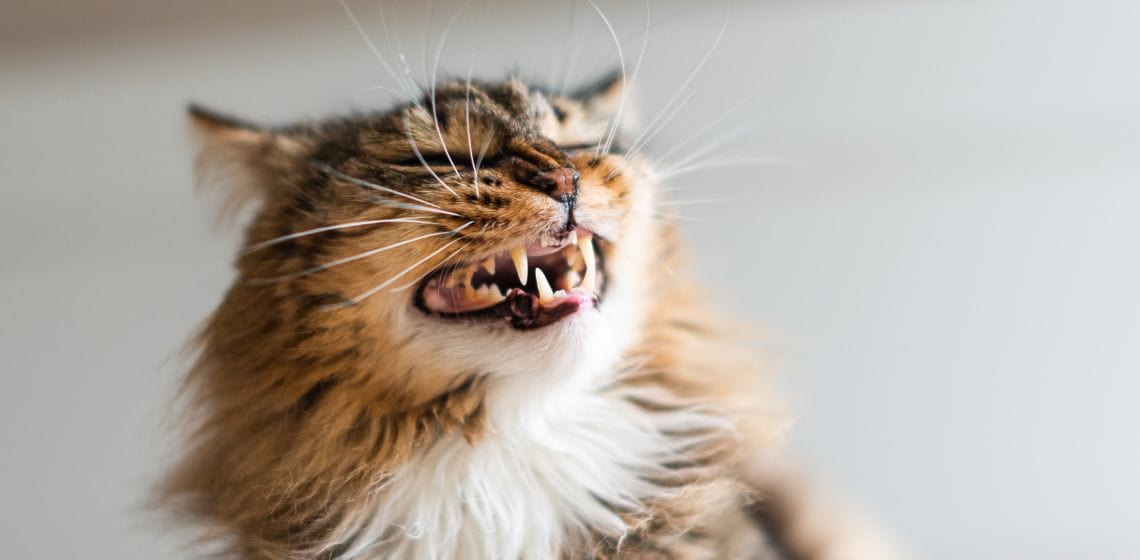
Table of Contents
While there are multiple types of dental disease, it often starts innocuously as plaque buildup but can quickly escalate, leading to painful infections, tooth loss, and even systemic complications if left untreated. Dental cleanings under anesthesia are essential; however, there are also things that pet parents can do at home to help keep their cat’s teeth in good shape. Keep reading for tips to help your furry family member sport a healthy, gleaming smile.
Understanding Dental Disease in Cats
Periodontal disease is a common form of dental disease in cats. This progressive condition affects the structures supporting the teeth, including the gums, bone, and ligaments. It is caused when bacteria form a film (plaque) on the teeth. Within days, this mineralizes and hardens into tartar or calculus, leading to the progressions below:
- Gingivitis : The earliest stage, where the gums become red, swollen, and may bleed easily. This stage is reversible with appropriate care.
- Early Periodontitis : Gums may start to recede slightly at this stage. There’s minor bone loss, but it might not be easily visible. The inflammation goes deeper than just the gums.
- Moderate Periodontitis : The bone loss becomes more evident, leading to gum pockets or spaces developing between the tooth and gums. This can make teeth loose and lead to bad breath.
- Advanced Periodontitis : At this critical stage, there’s significant bone loss (over 50%). The pockets deepen further, and infections are frequent. This stage often results in tooth loss and can have systemic implications, affecting the cat’s heart and other organs.
Recognizing the early signs and seeking early intervention can halt or even reverse the disease’s progression, ensuring the health and longevity of your pet’s teeth.
Feline Odontoclastic Resorptive Lesions (FORLs) represent another challenge specific to feline oral health. These painful lesions occur when the tooth’s structure gets eroded, exposing the sensitive inner part of the tooth. Cats with FORLs often exhibit mouth pain and discomfort while eating. Unfortunately, there is no way to prevent FORLs from developing, but vet check-ups can help detect them
Dental Care Tips From a Vet
Brush your cat’s teeth daily.
Brushing your cat’s teeth can be challenging, but it’s the cornerstone of good dental health. By removing plaque daily, you can prevent tartar buildup, which is a significant contributor to periodontal disease. Use a cat-specific toothpaste such as C.E.T. Enzymatic Toothpaste . You will also need an appropriately sized toothbrush or piece of gauze to wrap around your finger. Aim to brush the outer surface of your pet’s teeth in gentle circles, focusing on the gum line.
Use dental products approved by the Veterinary Oral Health Council
While nothing compares to brushing, it can be extremely difficult in some cats. Dental chews and treats are not only a yummy source of entertainment for your cat but also a handy tool for scraping away soft plaque. When your cat chews, the texture can help clean the teeth, much like a toothbrush. Water additives, sprays, and gels can provide an additional layer of protection against bacteria and can be especially beneficial for felines.
There are numerous dental products available, but if you want to find the ones that are proven to actually be effective, it is key to look for an endorsement by the Veterinary Oral Health Council. Additionally, it’s important to note that while these products may be beneficial, they should be used in conjunction with brushing and not as a replacement.
Consider a prescription dental diet
Dental diets are specially formulated cat foods crafted to tackle and prevent common dental challenges, such as the accumulation of plaque and tartar. Unlike typical dry food, the kibble in dental diets is designed with a specific texture and increased size. This design ensures that as a cat bites into the kibble, it scrapes against the teeth, assisting in plaque removal.
Beyond mere physical design, the ingredients also play a pivotal role. These diets often incorporate special additives or enzymes aimed at breaking down oral bacteria or modifying the saliva to make it less conducive for bacterial growth. Importantly, while promoting oral health is the primary objective, dental diets are complete and balanced and won’t neglect overall nutrition.
Recognize when to consult a veterinarian
Even with daily bruising, regular dental check-ups are vital. This involves a dental cleaning, exam, and x-rays under anesthesia. If any teeth are determined to be damaged or diseased, your vet may recommend removing them.
The frequency that your cat will need professional dental cleanings will depend on various factors, such as your their age, predisposition to developing dental disease, and overall health. However, if you notice bad breath, drooling, difficulty chewing, pain, or any swellings in the mouth or on the side of the face, it’s time to visit the vet. Early detection can make treatment more straightforward and prevent more serious complications.
Laying the Foundation: At-Home Dental Care for Cats
Starting an oral care routine for your cat might seem daunting. Cats are naturally independent creatures and can be resistant to changes in routine. Here are some steps to ensure a smoother transition and help set up a life-long routine to keep your cat’s teeth clean and healthy.
- Start Early : If possible, introduce dental care routines when your cat is a kitten. This normalizes the process early on.
- Be Gradual and keep sessions short : Initially, let your cat get used to having their face and mouth touched. Progress to using a piece of gauze wrapped around your finger or a cat-specific toothbrush slowly.
- Use Cat-Friendly Products : Always use toothpaste formulated for cats. Human toothpaste contains ingredients that can be toxic to felines.
- Positive Reinforcement : Reward your cat after each session, reinforcing the idea that dental care can be a positive experience.
- Consistency : The more you integrate dental care into your cat’s daily routine, the more accustomed they will become. Try to always brush their teeth at a certain time of day and in a specific location.
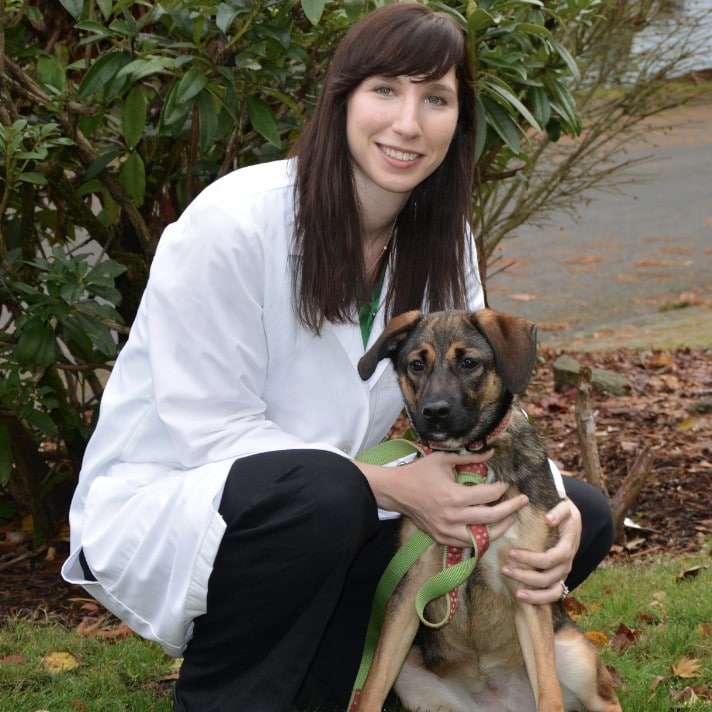
Liza is a veterinarian who graduated from MSU CVM in 2013 and spent five years working in small animal practice. She loved working with dogs and cats and educating owners on all aspects of veterinary medicine, especially animal behavior and dermatology. She has since transitioned to remote work to be able to spend more time at home with her husband, two young kids, and two cats. She is thrilled to be able to combine her passions for veterinary medicine and writing. She is licensed as a veterinarian in Washington State.
Recent Posts
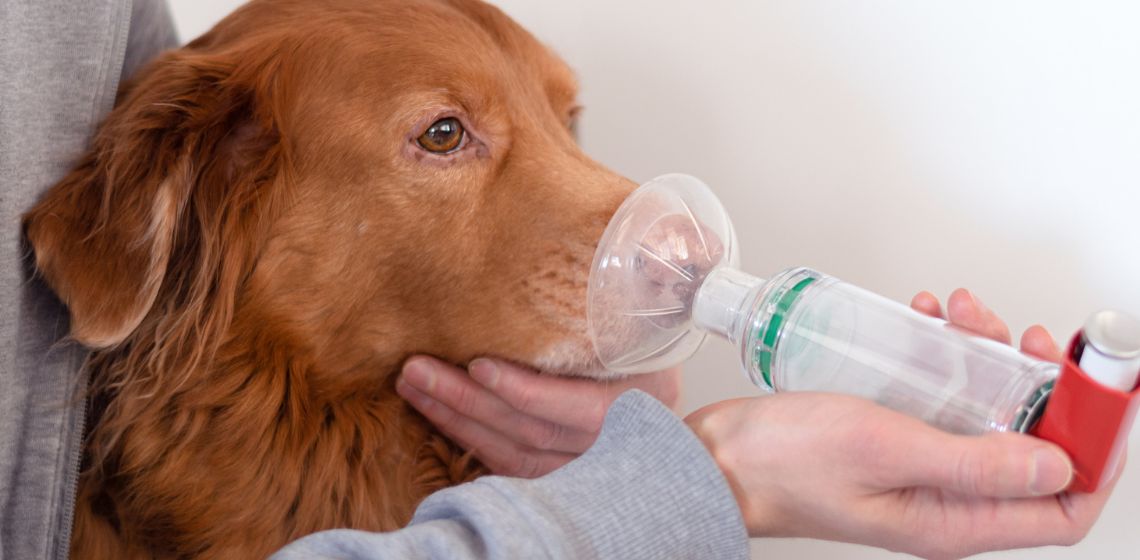
More Articles
Asthma in cats and dogs, proven ways to calm your anxious dog, can dogs eat peanut butter, subscribe to the vets newsletter.

- Total Wellness
- Our locations
- Refer a vet
- Become a partner
- Code of conduct
- Working Hours:
- Home Visits
8am – 6pm (Mon – Sat), varies by location
- On-call Support:
8am – 9pm EST (Mon – Sat)
Get the App:
Contact Us:
- [email protected]
- (844) 722-VETS
[email protected] (844) 722-VETS
Working Hours:
Home Visits: 8am – 6pm (Mon – Sat), varies by location
On-call Support: 8am – 9pm EST (Mon – Sat)
- Privacy Policy
- CA Privacy Policy
- Accessibility

Stay in the know
Use the coupon code below to get $20 off your first visit.

Please allow for one business day for our team to reply.
Get Our Newsletter
Sign up to receive our latest updates, tips, and exclusive offers. No spam.
Selling/Sharing Preferences
In order to complete your request, please complete the following information. By submitting this request, you are asking us not to share your information with third-parties in exchange of anything of value. For more details about your right to direct us not to sell your personal information, please see here.
By completing this form and clicking the "Send Request" button, you agree to our Terms of service and Privacy policy.
We Received Your Appointment Request!
One of our team members will call you soon to confirm the details of your appointment..

//supertails.com/cdn/shop/files/Frame_780_5dbfd820-8d63-424a-927f-98a03d3a5f33.webp?v=1687719537
Search for products & brands
- Consult a Vet

- Pet Friendly Villas

Caring for Cat Teeth: Tips and Tricks
Written by: Karuna Subbiah
October 15, 2023
Time to read 6 min
Your feline friend's infectious purr, mesmerizing gaze, and charming antics are probably what you adore most about them. But wait, there's a little secret behind those adorable traits - it's all about their dental health.
In this blog, we'll embark on an exploration of cat dental care, revealing why it's crucial, how to effortlessly maintain your cat's pearly whites, and the telltale signs to ensure your beloved pet keeps flashing a bright and healthy smile.

What's Inside?
Importance of oral care for cats.
Dental disease is the most common health problem in cats, and it can lead to many serious health problems, including tooth loss, pain, infection, and heart disease. That's why it's important to make sure your cat's teeth and gums stay healthy for the long haul.
Signs of Dental Problems in Cats
Dental problems are common in cats but often preventable and treatable. Here are some signs of dental disease in cats:
Bad breath: A mild fishy smell is normal for cats, but if your cat's breath smells foul, it could be a sign of dental problems.
Red or swollen gums: Healthy gums line should be pink and firm. Red, swollen, or bleeding gums could be a sign of gingivitis, the early stage of gum disease.
Tartar buildup: Tartar is a hard, yellow-brown substance that builds up on teeth. It can cause gum disease and tooth decay.
- Loose or missing teeth: Loose or missing teeth are a sign of advanced dental disease.
If you notice any of these signs in your cat, it's important to take them to the vet for a dental exam and cleaning.
Tips to Care for Cat Dental Health
Start your kitty's dental care routine by brushing your cat's teeth regularly. This may seem daunting at first, but it's actually quite easy to do with a little practice. There are a number of different types of cat toothbrushes and toothpastes available, so you can find one that your cat is comfortable with.
You should also provide your cat with dental treats and chews. These can help to remove plaque and tartar buildup from your cat's teeth. However, it's important to choose dental treats and chews that are specifically designed for cats, as some human dental products can be harmful to cats.
Steps to Brush Your Cat's Teeth
Apply a small amount of cat toothpaste to the toothbrush.
Gently lift your cat's lip and brush the outside surfaces of their teeth.
Pay special attention to the back teeth, as these are the most prone to tartar buildup.
Brush your cat's teeth for 2-3 minutes.
- Reward your cat with a treat or some praise after brushing their teeth.
How many teeth do cats have?
Adult cats have 30 teeth. This includes 12 incisors, 4 canines, 10 premolars, and 4 molars. Kittens have 26 teeth, but they lose their milk teeth and begin to grow their adult teeth at around 4 months old.
How to Brush Your Cat's Teeth?
Brushing your cat's teeth is one of the most important things you can do to keep them healthy. Dental problems are common in cats, and if left untreated, can lead to serious health problems, such as tooth loss, gum disease, and infections.
There are a variety of cat toothbrushes and toothpastes available. It is important to choose a toothbrush that is designed for cats, as human toothbrushes are too large and can damage a cat's teeth and gums. You should also use a cat toothpaste, as human toothpaste contains fluoride, which is toxic to cats.
How Often Should I Brush My Cat's teeth?
Ideally, teeth brushing for domestic cats should be done at least once a day. If your cat is new to brushing, you may start by brushing their teeth on alternate days slowly as they become more comfortable with it.
Ways to Keep Your Cat's Teeth Clean
In addition to brushing your cat's teeth, there are a number of other things you can do to keep their teeth clean and healthy. These include:
Dental treats : Dental treats for cats are a great way to help reduce plaque and tartar buildup on your cat's teeth. Look for dental treats that are specifically designed for cats and that contain ingredients that are safe for cats to chew on.
Water additives : There are a number of water additives available that can help to freshen your cat's breath and reduce plaque buildup. These additives are typically added to your cat's drinking water and are very easy to use.
Mouth Washes : Use mouthwash for cats on your cat's teeth and gums to help remove plaque and tartar. These products can be very effective, but it's important to use them as recommended by your veterinarian.
Dental toys : Dental toys are another great way to maintain your cat's teeth clean. These toys have ridges and grooves that help to scrape plaque and tartar from your cat's teeth.
- Feed Dry Cat Food : Dry cat food has a lower moisture which can help reduce the growth of harmful oral bacteria. This lowers the risk of dental issues and gum disease in your cat's mouth.
How to Choose the Right Dental Treat for Cats?
When choosing dental treats and chews for your cat, it is important to consider the following factors:
Size of the Treat: Make sure to choose treats and chews that are the appropriate size for your cat. Too small of a treat or chew could be a choking hazard, while too large of a treat or chew could be difficult for your cat to chew.
Texture of the Dental Treat: Some cats prefer hard treats and chews, while others prefer soft treats and chews. Experiment with different textures to see what your cat likes best.
- Ingredients in the Trea: Avoid treats and chews that contain artificial ingredients or ingredients that are harmful to cats, such as xylitol.
When to Visit the Vet for Cat Oral Care
If your cat has any of the signs of dental problems listed above, it's important to take them to consult a vet. The vet will use a special tool to remove plaque and tartar buildup from your cat's teeth. They may also need to extract loose or missing teeth.
It's important to have your cat's teeth cleaned professionally at least once per year. This will help to prevent dental problems from developing and keep your cat's teeth and gums healthy.
Throughout this journey into cat dental care, we've learned the importance of looking after your cat's oral health. Dental issues are common among domestic cats and can lead to tooth loss, pain, infections. Taking simple steps of precaution can keep your cat's teeth healthy.
From spotting signs of dental issues to adopting a straightforward dental care routine, you can make a positive impact. By starting with regular teeth brushing, choosing the right dental treats, and providing a balanced diet, you play a vital role in preserving your cat's radiant smile.
Remember, ask your veterinarian for guidance in case you want to address any concerns. This is important to maintain your cat's oral health. Regularly cleaning your feline's teeth help to prevent dental problems and contribute to their overall health.
In the end, your diligence in cat dental care is about more than just looks. A healthy cat mouth isn't only charming; it's the cornerstone of your cat's well-being. With your commitment, your cat can continue to share their enchanting smile, brightening your life and theirs, one purr at a time.
Share this blog

Read More Articles

The Importance Of A Good Dog Bed During Cold Weather
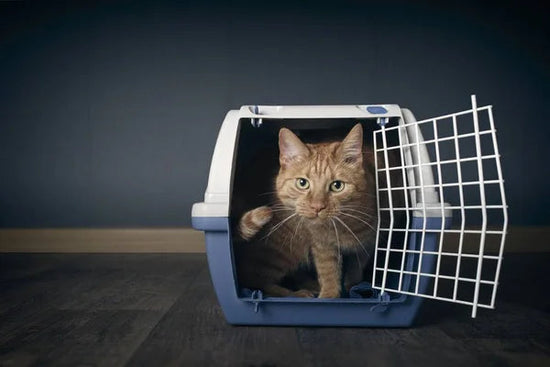
The Cat Carrier Conundrum: Tips for Stress-Free Travel Experiences
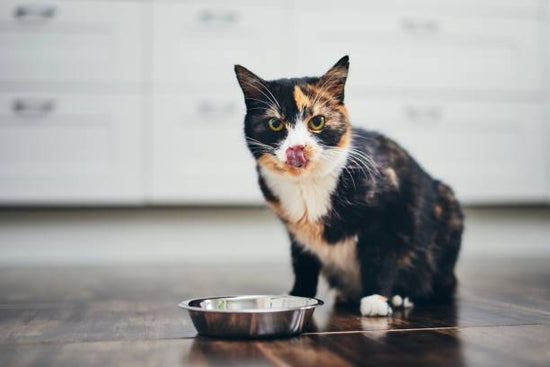
The Benefits of Salmon Oil Supplements for Cats: A Comprehensive Guide

Preventing Hair Fall in Dogs and Cats

Top 5 Reasons Why Your Dog Needs a Raincoat

Importance Of A Clean Litter Box: Promoting Your Cat's Health & Well-Being
Latest News

Keeping Cats Cool and Cozy: Essential Tips for Summer Heat

Ultimate Guide: Dog Paw Protection for Summer Adventures

How to Take Care of Your Older Dog During Winter Season

24hr Delivery
In 24 cities

1,50,000+
Happy pet parents

Complimentary vet consult
For every new member

Pet Pharmacy
- Offer Zone -->
- IPL Jerseys -->
- Puppy Corner -->

- Pharmacy -->

- Furnitures -->
- Carriers & Travel Supplies -->
- Cages & Crates -->
- Training Supplies -->
- Consult a Vet -->
- Dog Behaviour Consultation -->
- Kitten Corner -->

- Small Animals
- Rabbits -->
- Hamster & Guinea pigs -->
- Fish & Aquatics -->

- Shop By Breed

- All Medicines -->
- Dewormers -->
- Anti Tick & Flea -->
- Skin Care -->
- Eye & Ear Care -->
- Joint Care -->
- Liver Care -->
- Cardiac Care -->
- Kidney Care -->
- Digestive Care -->
- Respiratory Care -->
- Endocrine Care -->
- Wound Care -->
- Pain Medication -->
- Skin & Coat Care -->
- Multivitamins -->
- Calcium Supplements -->
- Appetite Stimulants -->
- Hematinics -->
- Trending Offers

- New Pet Parents
- Vet Consultation -->
- Dog Behaviour -->
- Track Order
- Frequently Asked Questions
- Customer Support
- Refer a Friend
2 item in cart
Skip Navigation
Where To Buy Sign Up & Save

- FIND THE RIGHT FOOD FOR YOUR DOG
SHOP BY AGE
- Adult (1-6) Dog Food
- Adult (7+) Dog Food
- Adult (11+) Dog Food
SHOP BY BRAND
- Prescription Diet
- Science Diet
- Bioactive Recipe
COMMON HEALTH CONDITIONS
- Food & Environmental Sensitivities
- FIND THE RIGHT FOOD FOR YOUR CAT
- Kitten Food
- Adult (1-6) Cat Food
- Adult (7+) Cat Food
- Adult (11+) Cat Food
- Skin & Food Sensitivities
- Our Company
- Nutritional Philosophy
- Sustainability
- Ingredients
- Quality & Safety
FOR PET PARENTS
- Information for New Pet Parents
- Articles and Education
- Puppy Nutrition
- Kitten Nutrition
COMMUNITY SUPPORT
- Food, Shelter & Love Program
- Natural Disaster Support
- Shelter Partners
- Pet Adoption Resources
- Contact Hill's
- Frequently Asked Questions
- Chat with Us
- Press Releases

COMUNITY SUPPORT

Keeping Your Cat's Mouth Healthy
- routine-care
Learn more about Hill’s commitment to sustainability
Find food that fits your pet’s needs
Find a dog food that fits your pet’s needs, find a cat food that fits your pet’s needs.
You brush your cat's fur regularly, but when was the last time you brushed their teeth? Though you might not think about it much, cat oral care is important. Read on for tips on how to identify and maintain healthy cat teeth.
A Healthy Cat Mouth

Strong, sharp teeth are equally important for pet parents to maintain. Your cat has thirty adult teeth, and they should be white, without any signs of yellow or brown plaque or tartar (the hard, scaly, or sticky deposits that cause tooth decay and oral disease). A normal cat tongue should be pink. Cat Health writes that if your pet's tongue is pale white, they may be suffering from anemia, and you should take them to the vet immediately.
A cat with bad breath can also be a sign that your cat is dealing with some oral issues. While a fishy or meaty smell after they have eaten can be normal, constant and consistent bad breath is not normal. So, if your cat snuggling up against your face causes you to plug your nose, it is worth taking your cat in for a dental check-up at your vet to make sure there aren't any underlying issues.
Why You Should Brush Your Cat's Teeth
Regular brushing is the most effective at-home cat oral care treatment to keep your pet's mouth as healthy as can be. You may not be looking forward to chasing a sprinting furball around the house so you can stick your hand in their mouth, but with gradual training, even the wiliest cat can learn to have their teeth brushed.
Not sure how to get started? The American Veterinary Dental College advises pet parents new to cat oral care to start slowly. First, let your cat get used to having their mouth touched. Take a moment every day to gently rub their face, and lift up their lips to look in the mouth. Once they are comfortable with that, you can put a small amount of toothpaste on your finger and let themlick it off. Feline toothpaste comes in flavors like chicken and seafood, so they may even view it as a treat. Next, try gently rubbing your finger over their teeth. Once they get used to the feeling, try an actual feline toothbrush. Don't forget: You should never brush your cat's teeth with a human toothbrush or human toothpaste, which contains ingredients that can irritate their stomach and make them very sick.
The earlier you can introduce your kitten to the concept of brushing their teeth, the better, so start as soon as possible. It can be more difficult to get older kitty companions to embrace oral care. Some cats also just aren't up for regular brushing. If that's the case with your pet, you can try an oral rinse, drinking water additives, dental chews, or specially formulated products like Hill's Science Diet Oral Care cat foods, which will freshen your cat's breath and help to reduce plaque and tartar.
Professional Cleaning
Just like you go to the dentist for oral care you can't get at home, your cat should go to the vet for a comprehensive cleaning. Usually performed under anesthesia, a professional cleaning will remove plaque and tartar in areas that you can't reach with a toothbrush, such as under the gum line. Most vets suggest scheduling comprehensive dental exams every one to two years, especially as your pet gets older. Depending on the dental issues your cat is facing, they may require more frequent cleanings.
Broken teeth are a common problem for cats, so your vet may also take dental X-rays to identify any issues beneath the gum line. Other common problems that could be identified through X-rays are periodontal disease, abscesses or infections. Although it may be worrying to place your pet under anesthesia for this procedure, it is necessary for the vet to properly check her teeth and assess her overall oral health.
Signs of Dental Problems in Your Cat
It's worth noting that many common dental issues cause intense pain. But, as Vetwest Animal Hospitals points out, cats' wild ancestors who show signs of being sick are vulnerable to predators — meaning to this day, your pet may try to hide it if she has a toothache or other ailment.
According to Harmony Animal Hospital , bad breath — also known as halitosis — is the most common clue that your kitty may be in need of some oral care. Other signs include:
- Eating difficulties
- Problem gums
- Stained teeth
- Loose and broken teeth
- Tumors on gums
- Pawing and drooling
You know your cat best and will be the first one to spot any of these unusual signs. Contact your vet if your pet's eating habits change or they seem to be in pain.
Cat Oral Health Problems
Cats are prone to a variety of dental and oral issues, especially as they age. Here are some common conditions to watch out for:
- Broken teeth: Cats of all ages can break a tooth for a variety of environmental and health reasons. Your vet will decide whether to remove a fractured tooth based on where in the mouth the tooth is located. Broken teeth will be addressed in radiographs as part of their anesthetized dental visit to make sure the root of the tooth isn't affected or that there isn't a larger oral disease lurking below the gumline.
- Gingivitis: This inflammation of the gums is caused by the accumulation of plaque. Untreated gingivitis can develop into periodontal disease, which attacks the gums and the bone holding your pet's teeth in place.
- Tooth resorption: The cause of tooth resorption is a mystery, despite the fact that it affects close to three quarters of all cats who are five and older, according to the Cornell Feline Health Center . In this condition, the tooth's inner material called dentin erodes and causes broken teeth and painful chewing.
- Periodontitis: In this gum disease that affects senior cats, the ligaments and tissue surrounding teeth recedes and exposes the root. Affected teeth often need to be extracted.
- Stomatitis: Similar to the inflammation of gingivitis, bacteria can spread throughout the mouth and infect the tissues in your pet's cheeks and throat. Veterinary Practice News warns that this condition can be quite painful for your feline companion. Stomatitis is often more common in cats that have FIV (feline immunodeficiency virus), but you should contact your vet immediately if you see that your cat's mouth is red and swollen or they whimper when trying to eat.
If you notice any of these issues or suspect your cat has a dental problem, bring them in for a checkup as soon as possible. Dental health issues are painful and serious for your cat—just as they are for you. By cleaning their teeth at home and taking them in for regular cat oral care vet visits, you can help them have a healthy mouth for the rest of their life.
The Basics of Cat Dental Care: Keep Your Feline Friend’s Smile Bright
Cats are known for their independence, agility, and adorable whiskers, but their tendency for dental challenges is often overlooked. Cats tend to hide pain and discomfort, and they are not as likely to lick your face like dogs may, exposing foul-smelling breath that can tip you off to dental disease. Since cats often mask the signs of dental disease, it is important for pet parents to be diligent in knowing what to look for in potential problems and how to prevent them.
Dental problems are very common in cats, with some studies reporting more than 70% of adult cats experience dental disease. The most common forms of these diseases are largely preventable or treatable with appropriate preventive dental care and monitoring, but unfortunately, less than 20% of pet parents regularly clean their cat’s teeth.1 Dental diseases can lead to pain, infection, and even affect their overall health. Bacteria from dental disease can spread systemically to the kidneys, heart, and liver. In addition to preventing systemic problems, good dental health is also essential to ensure that cats can comfortably obtain the necessary nutrition to support them throughout life.
Recognizing the signs of dental problems in your cat is the first step in providing proper care. One of the first signs may be bad breath. Bad breath, also called “halitosis,” can be caused by a variety of factors other than dental disease, but by far, the most common reason is poor dental hygiene. Pet parents should pay attention to other subtle changes in behavior and habits that might indicate discomfort. Some signs of dental pain in cats can include:
- Changes in eating or drinking habits
- Decreased grooming
- Hiding or isolating themselves more than usual
- Aggression or irritability
- Pawing at the mouth or head shaking
It is important to observe for all the above signs, because cats are very adept at masking pain. This is a behavior that can be traced back to their evolutionary instincts. There are several reasons why cats tend to conceal their pain. In the wild, showing signs of weakness or pain can make a cat vulnerable to predators. Thus, cats have evolved to mask pain as a survival strategy. They are less likely to attract the attention of potential threats if they don’t display signs of injury or illness. Cats tend to have a stoic demeanor, and their facial expressions and body language are generally less expressive than those of dogs, which can make it more challenging to detect pain based on visual cues alone.
Other signs of dental disease require a visual examination of your cat’s mouth, best performed by a veterinarian. When your veterinarian examines your cat’s mouth, they check for, among other things, plaque, tartar, gums, and breath. They may notice a visible buildup of tartar and plaque as yellow or brown accumulation on your cat’s teeth, which can lead to gum disease. And in severe cases, there may be wiggly or missing teeth. Similar to people, cats benefit from regular dental checkups and cleaning. Schedule appointments with your veterinarian at least once a year for a thorough examination of your cat’s oral health.
In addition to professional checkups and cleanings, you can take steps to maintain your cat’s dental health at home. This not only keep your cat’s teeth and gums healthy, it also helps to minimize additional costs that can incur during professional cleanings. Depending on the area, the average cat dental cleaning cost in the US is around $200-400 (excluding pre-anesthetic blood work, anesthesia/monitoring, x-rays, medications, etc.) and the cost can increase with more severe dental disease that may require tooth extractions, which cost on average $50-130 per tooth, and additional medication for treatment. The most popular way for pet parents and cats to help support oral health, is to give daily dental treats, such as the WHIMZEES cat dental treats . Providing dental treats can be an enjoyable way to bond with your cat while reducing plaque and tartar buildup to keep the breath fresh and the gums healthy. Some pet parents choose dental cat foods that are designed to clean teeth as your cat chews. And finally, as daunting as it may sound, with training and consistency, daily brushing of your cat’s teeth is optimal.
If your cat develops dental disease, you should visit your veterinarian who may recommend testing and treatments such as a dental x-rays and professional dental cleaning. These may be necessary to remove tartar and plaque buildup. In severe cases, damaged teeth may need to be extracted to prevent further issues. When indicated, antibiotics or pain medications may be prescribed to address infections and discomfort.
Taking care of your cat’s dental health is a vital aspect of responsible pet ownership. Regular checkups, at-home care, and early intervention can ensure your feline friend enjoys a healthy mouth and a happier, longer life. Make cat dental care a priority and keep that adorable smile shining bright!
References:
- “Feline Dental Disease | Cornell University College of Veterinary Medicine.” Cornell University College of Veterinary Medicine, 4 Oct. 2017, https://www.vet.cornell.edu/departments-centers-and-institutes/cornell-feline-health-center/health-information/feline-health-topics/feline-dental-disease#:~:text=Diseases%20of%20the%20teeth%20and,preventive%20dental%20care%20and%20monitoring.
Be the best pet parent you can be. Join for expert advice.
We send coupons too!
Share This post
Related products.
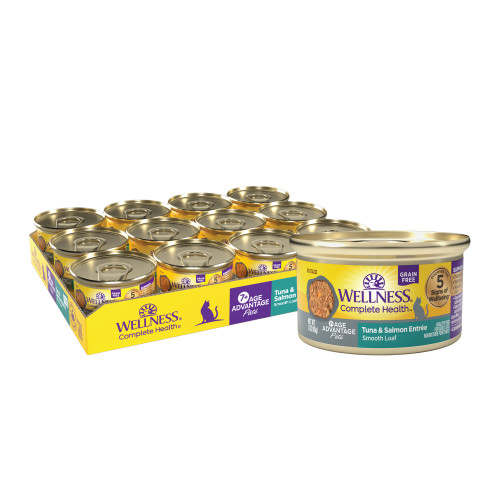
Wellness Complete Health Pate
Age Advantage Tuna & Salmon
WHERE TO BUY

Chicken Entree
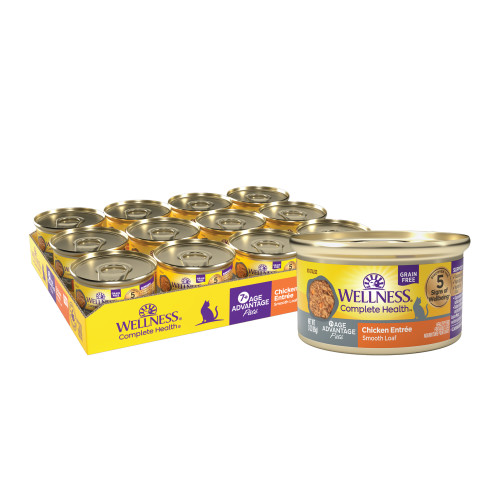
Age Advantage Chicken

Wellness CORE+ Wholesome Grains
Original Turkey & Chicken with Freeze Dried Turkey
Related Blog Articles
Pets and human mental health.
Furry Healers: The Transformative Power of Pets on Mental Wellbeing In an ever-evolving world fraught with stressors and uncertainties, the bond between humans and their furry companions has emerged as a beacon of solace and support. As a global concern it is estimated that 970 million people in the world have a mental disorder.1 Beyond […]
Entertainment
General Care
Health & Nutrition
Seasonal Tips
Springtime Shedding: Managing Your Cat’s Coat During the Seasonal Change
Tips for Spring Cat Shedding Control, Inside and Out Cat hair everywhere? If it seems like your cat’s shedding more than usual every time spring rolls around, it’s because…they are! “First and foremost, seasonal shedding is common and normal for cats of all breeds,” reminds Dr. Danielle Bernal, D.V.M. and Global Director of Vet Nutrition […]
Dental Care
How Often Should You Brush Your Dog’s Teeth
Good dental care is important to your dog’s health and happiness. Just like us, dogs need daily at home dental care and, while it is ideal to start when your dog is young, it is never too late to begin caring for your dogs’ teeth. Without proper dental care, dogs can easily develop dental diseases. […]
Get exclusive savings, pet care tips and more!
Sign up for our newsletter and stay up to date with all things Wellness ® . Every edition will feature product news, special offers, and exclusive savings. Sign up today!.

Item added to your cart
Products( )
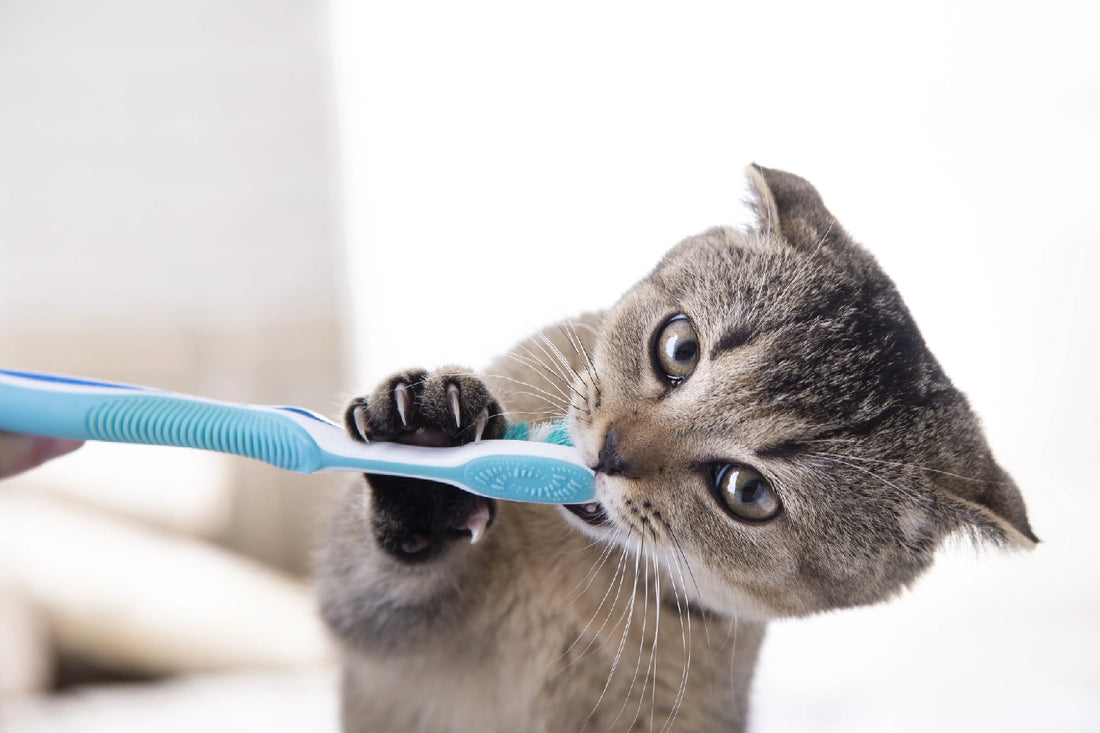
Cat Dental Cleaning: What To Expect And How To Prepare
You schedule your vet appointment yearly, but are you keeping up with your cat’s dental health? Just like humans, your feline friend should also be getting a check-up on their choppers. A cat dental cleaning will help ensure that your pet’s oral health is A-OK.
In this article, we’ll let you know what to expect during your cat’s dental cleaning and how to best prepare for it. We’ll also give you some tips for in-between visits to keep your feline’s teeth clean and healthy.
The Importance Of Cleaning Your Cat’s Teeth

Get out that toothbrush! Your cat’s dental health has a big impact on their overall health, and it’s up to you as their pet parent to make sure their teeth are in tip-top shape. Without proper oral care, they may end up with gum disease, tooth decay, infections, and even bad breath.
In addition to helping prevent dental disease , cat dental cleanings also cut down on your cat’s risk of heart and kidney disease. That’s because plaque buildup on the teeth can capture bacteria that spreads to the bloodstream, and then to the heart and other vital organs.
Cleanings can lessen plaque buildup and, as a result, the risk.
Many people think because their cat doesn’t show signs of distress, their teeth are doing just fine. However, cats are notoriously tight-lipped about aches and pains, so they might be suffering a tooth condition right under your nose.
Besides that, much of the tartar can build up under your furry friend’s gumline, so you won’t necessarily see it.
The best thing you can do is make an appointment with your vet to take a look at your cat’s pearly whites.
Cat Dental Cleaning: What To Expect
If your cat hasn’t had their teeth cleaned before, it’s good to know what to expect so you can best prepare for their trip to the “dentist.”
Physical Exam

Before beginning the cleaning, the vet will perform a physical exam to confirm that your kitty needs it. They’ll also take note of potential dental issues.
After that, your vet will likely take some of kitty’s blood for a pre-anesthetic blood test to ensure your cat’s liver and kidney functions are strong enough for anesthesia. Your vet also may take a look at your cat’s heart and abdomen.
If they notice signs of severe infection during the exam, they may prescribe an antibiotic prior to the cleaning. Once your kitty gets the go-ahead from the vet, it’s time to schedule your cat's dental cleaning.
A cat dental cleaning is a little more involved than your own trip to the dentist, as your cat’s sharp teeth and claws make it impractical to do while they’re awake.
The cleaning will require general anesthesia , which makes all parties more comfortable — cat and vet alike. This will allow the vet to carefully and thoroughly look in their mouth without stressing the cat.
IV Fluids And Antibiotics
Your little kitty will be fitted with an IV catheter when under anesthesia in order to deliver fluids and possibly antibiotics during the procedure. The vet will monitor their vitals while they clean their teeth to ensure that your cat’s heart rate, respiration, and blood pressure are stable.
It’s common for cats whose teeth look outwardly normal to have hidden issues below the gumline. Your vet will have to take x-rays in order to see if there are lesions, decay, bone loss, cysts, or retained baby teeth below the gumline.
Scaling And Polishing

Your vet will remove tartar by scaling your kitty’s teeth first, using hand and ultrasonic scalers. As any tartar below the gumline is the biggest culprit in dental disease, they will address this area thoroughly.
In addition, the vet may use a dental probe to look at gum bleeding and pockets that are ripe for decay. After scaling, they’ll polish your cat’s teeth and apply a protective sealant.
Extractions And More X-Rays
As it’s hard to predict what your cat will need before the cleaning, you’ll want to stay reachable so the doctor can contact you with any questions during the procedure.
If your cat is found to have more advanced dental disease, the vet may have to perform an extraction of one or more teeth. If they have to do an extraction, they’ll numb and pull the diseased tooth and then suture the hole so it can heal.
After extracting the tooth, your vet will do a second X-ray to be sure the tooth was removed entirely.
The cost for a cat dental cleaning could vary from $200 to $2000 or more depending on your location and whether your pet has any disease or requires extractions. It’s always smart to have pet insurance, which may defray the cost a bit.
After your kitty’s dental cleaning, let them take it easy. Once your cat is back at home and settled, give them a small amount of soft food and lots of TLC.
If your cat had an extraction, your vet may prescribe an antibiotic or pain medication.
Cat Dental Cleaning: How To Prepare

Because your cat will have general anesthesia for their dental cleaning, it’s important to follow your vet’s recommendations in terms of prepping them for the procedure.
Food And Water
Surgery should be done on an empty stomach, so withhold your pet’s food at least eight hours before your scheduled cat dental appointment. As for water, they should be able to drink only up until the morning of the appointment.
You’ll want to make sure the vet knows all of the medicines that your kitty is on so they can give you specific instructions in preparation for the cleaning.
Keeping Up Good Cat Dental Habits
As we said, oral health is key to the overall health of your kitty, so it’s best to make good dental habits part of your daily routine. Here are some things you can do.
Indulge In Dental Treats And Toys
An easy way to take care of your cat’s oral health is to add dental cat treats to their diet . GREENIES™ Feline Dental Cat Treats help clean your kitty’s teeth while reducing tartar and freshening their breath.
In addition to treats, hard chew toys can help get rid of tartar and keep your cat’s teeth healthy. Treats and toys are best used in addition to a brushing routine and a healthy diet, which we’ll discuss below.
Brush Your Cat’s Teeth Daily

Brushing your cat’s teeth daily is the best way to stave off dental disease.
The American Veterinary Medical Association suggests starting early, while your kitty is young. You can start with cat-friendly toothpaste and gauze when they’re a kitten and progress to a bristled finger brush as they get older.
Stimulate Their Gums
As part of a good dental routine, you’ll also want to stimulate your kitty’s gums by massaging them. This can strengthen their gums and make them heal faster.
Try A Dental Diet

Consider putting your kitty on a dental diet in order to support their oral health. A dental diet generally consists of larger kibble sizes so your cat will have to chew more, and the fibrous food scrapes the tartar from the teeth.
However, before changing your cat’s diet, it’s best to talk to your vet so they can recommend the right diet to maintain your kitty’s overall health.
Give Them Fresh Water
Fresh water helps clean your furry friend’s teeth after a meal, washing out any debris left over from the food.
Visit Your Vet Regularly
Of course, you’ll want to visit your vet regularly to keep up with your pet’s overall health, including their teeth.
Tip: If your kitty has any medication to take, our Feline Pill Pockets can make it more palatable for them!
Look Out For Any Changes
Now that you’ll be very familiar with your little kitty’s mouth, you’ll want to be on the lookout for any changes.
Check their gums using the “ flip lip test ” — healthy gums are pink. If they are red, yellowish, or bleeding, you’ll want to make a vet appointment because those signs could indicate dental disease .
Also, look for changes in appetite or any hunger strikes that last more than a couple of days. These behaviors could also indicate an issue with your cat’s teeth.
Smile, Kitty!

As we said, your cat’s oral health is closely connected to their overall health. Having a cat dental cleaning can help stave off conditions like gum disease, tooth decay, bad breath, and even heart disease.
In this article, we told you what to expect at your cat’s dental appointment and how to prepare. We also walked you through several things that you can do in-between appointments.
Consider adding our GREENIES™ Cat Dental Treats in flavors like roasted chicken , savory salmon , tempting tuna , and even catnip to your daily routine to maintain your cat’s oral health. The crunchy texture cleans teeth, reduces tartar buildup, and even freshens breath.
Include GREENIES™ in your kitty’s dental health plan to keep your feline friend smiling wide!
Cornell University College of Veterinary Medicine
National Library of Medicine
You're $ 50.0 Away from free shipping!
Congrats, You have got FREE shipping!
Your cart is empty
- Choosing a selection results in a full page refresh.

Cat Dental Care: Stop Oral Disease Like A Boss (9 Easy Steps)
Dental diseases are the most frequently diagnosed problem for cats, and part of keeping your cat happy and healthy is caring for her teeth and gums!
Unfortunately…
It’s also one of the most overlooked issues due to our lack of knowledge when it comes to caring for and noticing problems with our cat’s teeth.

In fact, according to the American Veterinary Dental Society, about 75% of cats show signs of oral disease by the shy age of 3. [1]
This can lead to more than just bad breath in your cat…
The bacteria that gather in an infected pet’s mouth can actually get into their blood-stream and lead to serious consequences!
This could potentially affect your kitty’s kidneys, heart or liver. [2]
My first brush with feline dental care was quite dramatic, as we realized my shelter cat (with a guessed age of 9) had lost quite a few of her teeth over one summer.
After taking her to the vet and having her teeth cleaned (and two removed), we looked back on the summer and realized that there were so many little clues that she gave to alert us to her pain and we just were oblivious.
It’s sad to think…
But this is a fairly common (and fairly over-looked) problem with cats.
So I wanted to dive right into it and give you the entire scoop on feline dental care.
Talking about signs and symptoms, how to clean your cat’s teeth and what to do if your cat is struggling with dental problems.
So, first…
An overview of your cat’s mouth will get you familiar with your cat’s oral needs – check out the video below!
How Do I Know if My Cat Has Dental Problems?
There are 3 types of diseases that might affect your cat’s teeth and gums.
- Gingivitis. The most common of the three, gingivitis is the build-up of plaque that hardens on the surface of your cat’s teeth. Gingivitis can cause gum recession and/or inflammation.
- Periodontitis. A gum disease, periodontitis is when the gums become very inflamed and start pulling back (recession). This is the next stage after gingivitis.
- Feline Resorptive Lesion. This is less common, but it’s essentially a kind of cavity that forms near or below your cat’s gum line.
Periodontal disease in cats is so common that the Cornell Feline Health Center has estimated about 85% of cats over the age of six have struggled with this. [3]

Noticing your cat is in pain can be one of the most difficult things – and then identifying where that pain is can be a whole other issue.
When it comes to pain, cat’s have their own little language and sometimes it’s hard for us humans to catch on.
Some symptoms you can watch for that could indicate dental problems in your cat are:
- Drooling or jaw-chattering. If your cat is producing more drool (saliva) or you notice her mouth/jaw shivering – this is a problem (especially if your cat has never exhibited these symptoms before).
Our pretty girl took to hiding in our neighbor’s bushes.
- Increased irritability that can’t be explained by anything else. This one can be a bit harder to pinpoint, as cat’s moods can change due to a few different reasons – but if you couple this with any one of these other symptoms, your cat is likely suffering from dental issues.
Did you know? Kittens have “milk teeth” (what we would call baby teeth) – these begin to come in around 4 weeks old. Cats have “adult teeth” (similar to us) – and these begin to come in to replace the milk teeth around 5 months old. Kittens have 26 milk teeth. Adult cats have 30 teeth.

Caring for all of those teeth can be a bit tricky, especially when you did not introduce some kind of teeth cleaning routine into their lives when they were young.
Here’s how we’re doing it…
How To Brush Your Cat’s Teeth
Cleaning your cat’s teeth doesn’t have to be the nightmare you’re thinking it could be.
And once you set the routine, it’s quite easy to maintain.
How to Brush Your Cat’s Teeth in 9 “Easy” Steps :
- Find a comfortable place for your cat. This could be your cat’s favorite spot or your lap – wherever your cat is most comfortable.
- Use a pet toothbrush (or one of the alternatives to this, which I’ll talk about below) and toothpaste that is made for cats .
- Give your cat a sample of the toothpaste and let her become familiar with the brush you will be using (letting her sniff it or bite it).
- Lift your cat’s lip to expose her gums. You can also pull her lip back gently to allow for more teeth to show. You should be able to see all of her teeth and gums on one side at a time.
- Brush with gentle motions , stopping if you sense your cat needs you to stop.
- If you can, clean the inside of her mouth with a damp cloth (as most cats will not like you cleaning the inside of their teeth with the brush.
- Make sure to get the back molars and canine teeth , as these are the areas that can build up the most plaque.
- Wipe away access toothpaste.
- Give your cat some love!
Watch the video below on how to do thorough teeth cleaning on your cat:
When Should I Introduce a Teeth Cleaning Routine to My Cat?
Start healthy habits young, if you can.
Preventative dental care is the best kind, right?
Introducing oral cleaning into your kitten’s routine is easier than you think, following the steps above and the video below.
What do I use to brush my cat’s teeth?
You can implement teeth cleaning in your kitten by starting her off with one of these super cute finger toothbrushes and toothpaste.
As your cat gets more used to the cleanings (or grows older), you can switch to a pet toothbrush.
However…
What I found most effective, was a baby’s toothbrush !
As most pet toothbrushes can still be quite large for a cat’s small mouth and may cause your cat discomfort, a baby toothbrush seems to be just the right size. (We started with a finger brush and gradually worked up to a baby toothbrush after a few months, and she’s gotten used to it!)
How to Introduce Your Older Cat to a Dental Care Routine
It’s never too late!
If you’re like me (and really had no idea about dental health care for cats) you can still start a routine with your older cats now.
Introducing your older cat to a dental care routine can be a bit trickier, as they haven’t grown up with this habit and have to all of a sudden be faced with this foreign object with weird-smelling paste poked at their gums.
The video below has great tips to help you effectively brush your cat’s teeth:
It can be a bit daunting for both human and feline – but it’s possible and very much worth the effort.
Cleaning Your Cat’s Teeth (if you’ve never done it before):
- Let your cat become familiar with the toothbrush and toothpaste , letting her sniff it, bite it or play with it if she wants.
- Take it slow and have patience. This is a very new step in your cat’s routine and may take a while for her to sit through teeth cleaning without issue.
- Find your cat in a good mood. If your cat is already agitated or annoyed (or playful and not wanting to sit still) – it will be a nightmare for you both.
- Lastly, keep at it. Persistence is key to introducing any kind of routine to an older animal. Eventually, you will both get used to it.
My Cat Won’t Let Me Brush Her Teeth… What Do I Do?
If you’ve tried to no avail, the next best thing you can do is speak with a veterinarian and ask for demonstrations on proper teeth cleaning.
Don’t you wish all cat teeth cleaning could go this smoothly?
This sweet kitty loves his toothbrush! Well, mainly the flavor.
After a vet visit for proper instruction and all of the patience in the world – your cat may not be adjusting well to their new dental routine (or you may not have the time to clean their teeth as much as you’d like).
You’re left thinking:
“Now what?”
There are a lot of different dental rinses, oral care diets and dental treats that can help give your cat a boost in their oral care.
So, here’s the deal…
Dental Rinses for Cats: Does It Work?
A relatively easy alternative to brushing cats teeth could be to incorporate a dental rinse into their routine.
Oral rinses that contain the ingredient “chlorhexidine gluconate” is what we’ll be looking for, because they are really effective antiseptics.
You can read more about that here .
The dental rinse I’ve come across that has the most praise is Dentahex Oral Rinse for cats and dogs .
IMPORTANT: Use only dental rinses that are pet safe!!!
Because your cat will be swallowing this rinse, it’s very important to make sure you buy a product that is specifically for cats.
These types of products should not contain foaming additives or harsh ingredients.
Look for a brand that displays the Veterinary Oral Health Council seal (shown here ) , as these would meet standards that are proven to slow the accumulation of tartar and plaque and will be safe for cat consumption.

Dental Treats for Cats
You’re probably wondering:
“Do dental treats actually work?”
Dental treats (tartar control treats and dental chews) are good in moderation, but even then there is debate over whether dental treats work or if they are just a mask to cover up a more serious issue.
One thing we know for sure…
They are not an effective supplement for brushing your cat’s teeth or having teeth cleaning at a vet’s office.
Greenies or any other dental treat for animals can make your pet’s breath smell better (which is nicer for us), however, it’s very similar to buying dry pet food that claims to prevent tartar and plaque build up.
While this could be partly true, it’s very unlikely that giving dental treats to your pet will actually prevent oral issues in the future.
It could help in some small ways, and of course, we all like to reward our cats – but I wouldn’t rely on this to be your only dental care for your kitty.
And the next big question…
possibly the biggest question…
What Kind of Food is Best for My Cat’s Teeth?
Can we do things in our cat’s day to day life that encourages and promotes healthier teeth and gums?
Absolutely!
The food you choose for your pets do have an impact on their teeth, their health and their life.
However, things aren’t as cut and dry as choosing a specific cat food and thinking that will cover your cat’s oral health completely.
Jean Hofve , a holistic feline veterinarian says this on cat food choices affecting your cat’s mouth;
“In my experience as a feline veterinarian, I’ve probably examined at least 13,000 cats’ mouths. There was no real pattern to the dental and periodontal disease I saw. If anything, tartar and gum disease seemed to be more attributable to genetics or concurrent disease (such as Feline Leukemia or feline AIDS) than to any particular diet . I saw beautiful and horrible mouths in cats eating wet food, dry food, raw food, and every possible combination. Many of my patients initially ate mostly or exclusively dry food; yet these cats had some of the most infected, decayed, foul-smelling mouths I saw. If there was any dietary influence at all, I’d say that raw-fed cats had better oral health than cats on any type of commercial food. However, the overall effect of diet on dental health appeared to be minimal at most .”
This might be totally frustrating for you to hear because it’s fairly conflicting with everything out there.
There are so many diets, treats, and foods that claim to lessen the chance of dental issues in your pet – and that’s why we buy them.
While all of these things may indeed strengthen your cat’s immune system and mouth to protect against diseases, there are a lot of different factors that contribute to that.
Which is why no one specific thing you could do will totally save your cat from ever experiencing a dental issue.
What I take away from my research (and quotes like that of Jean Hofve) is that there isn’t ONE SPECIFIC THING that you can do to “make sure” your cat never has dental problems.
There are so many factors that contribute to dental decay or gum diseases – food is one of them, but genetics and other risk factors play a role too.
Don’t be discouraged!
Just because there isn’t one specific thing you need to do, doesn’t mean you shouldn’t do anything.
Your cat depends on you to give her the best protection you know how to…
If you continue making the best choices you can in regards to food, dental care, and maintenance, your cat will be happy!
Let’s take a look at what we can do…
What to look for in cat food that will benefit your cat’s teeth and gums:
- Prevents bad breath
- Prevents tartar and plaque build-up
- Prevents gingivitis and/or bleeding gums

Which is better for my cat’s teeth – wet or dry food?
This is one of the bigger debates and as an answer, I’m going to say that it varies (which, I know, doesn’t make things any clearer…)
Keeping in mind:
Your cat’s age, weight, and current oral health condition – your vet may have some specific recommendations on what to feed your cat – so my advice is to consult your vet!
I know that’s not exactly the advice you were looking for (as most search about this topic to get one precise answer) – but every cat has different oral care needs and this is the best way to find out what is going to truly be the most helpful for your cat.
Let’s talk about this…
Has plenty of benefits for cat’s oral health; it makes muscles and bones strong, it’s easier for cats to chew. It’s also known to have fewer additives than dry cat food.
Click through to read my post: [ best kinds of wet cat food for your feline friend.]
DRY CAT FOOD has some benefits as well – the biggest being that it’s thought that the chewing involved in dry food could help clear debris and plaque off your cat’s teeth. (my opinion is it really doesn’t help too much)
[Check out our post on dry cat food to learn more about the pros and cons!]
And then…
Is more of a new up and comer diet for your kitty, but it’s turning quite a few heads (and for the best reasons.)
Raw meat diets may also have benefits for your cat’s teeth such as making the gums, teeth and jaw bone strong from tearing into meat (much like they as carnivores should).
The video below shows Ginger Kitties Four – Raw Meat Chunks: Keep Your Cats Teeth Healthy
In fact, according to a study by the Feline Nutrition Foundation , the act of eating raw meat (the chewing and gnawing) is like polishing the surface of the cat’s teeth and works at preventing the buildup of tartar and plaque.
It’s basically the equivalent of brushing and flossing for humans.
The most interesting part…
The video below is a study conducted by Dr. Tom Lonsdale and it’s actually quite shocking to see what 17 days of a dry food diet does for dog’s oral hygiene.
The discoloration and deterioration of their teeth in just over two weeks is fairly noticeable, as well as a few of them actually losing weight.
While this experiment was conducted with dogs, it’s safe to assume that cats may suffer from some of the same damage to their teeth while on a completely dry food diet.
What Do I Do if My Cat Loses a Tooth?
Finding my eldest cat in the sleeping in the bushes one evening, I didn’t expect to find her minus a tooth – but that’s what we found.
Turns out she’d had an infection and lost a tooth all on her own without us noticing.
I shoved the guilt aside and took her to her vet for a teeth cleaning.
They ended up pulling out another infected tooth and giving her remaining teeth a very good cleaning.
Did you know? A mere 10 % of cats actually keep all of their adult teeth throughout their lifetime. [5]
While it’s easy to feel overwhelmed and sad if your cat loses a tooth, the most important thing would be to get them to a vet – because there could be more infection in their mouth that you don’t know about.
Your cat may need to have more teeth pulled or have her teeth cleaned , and for this, she will likely be put under general anesthesia.
Some vet offices (like mine) allow you to be with your cat during this process if that makes you feel more comfortable.
This is a very low risk and quite common, sometimes taking as little as half an hour to be done.
How often you get your cat’s teeth professionally cleaned will depend on quite a bit on how often you brush their teeth.
If your cat isn’t happy with teeth cleaning or for some reason you don’t do them often, you will need to visit your vet for cleanings more often.

Feline Dental Care FAQ
⚙ How often should you have your cat’s teeth cleaned by your vet?
How much does this cost?
At least once a year , perhaps more depending on your cat’s oral hygiene routine.
Check your cat’s teeth at least once a month.
If you notice yellowing or tartar accumulation, go to the vet for a professional cleaning.
It’s much better to go more often than you need (at which point your vet would explain how often you should be coming in) than not to go at all.
When untreated, gingivitis can progress to periodontitis which is not reversible.
As for cost (in the USA), you should expect somewhere around $300.
This may seem expensive, but part of this cost is the cost of anesthesia (usually around $100-$150), which your cat will need during the cleaning.
Additional costs for medicines your cat may need could be extra, and of course, every clinic’s costs will vary.
However, don’t let the cost deter you.
If you have this done annually, it will be the best choice for your cat and she will thank you with lots of lovely smelling kisses!

⚙ How many teeth do cats have?
Cats have 30 teeth.
When it comes to feline oral care, the teeth aren’t the only thing to pay attention to – cats are very prone to gum diseases as well.
⚙ Is it normal for a cat to lose their teeth?
A kitten, yes . An adult cat, no.
Much like their humans, kittens lose their “milk teeth” around a few months of age and these are replaced with adult teeth.
Although it’s fairly common for cat’s to then lose some of their adult teeth, these teeth cannot grow back or be replaced – so the goal is to keep your cat’s mouth as healthy as possible so they don’t lose their adult teeth.
⚙ How often should I brush my cat’s teeth?
In an ideal world, brushing your cat’s teeth daily is the best, as plaque can harden within 48 hours.
Understandably, this isn’t do-able for a lot of cat-owners for various reasons – so I decided to ask my own local vet what her thoughts were on this, and this is what I’ve learned…
Brushing as much as possible is always ideal, and that looks different for everyone.
It’s recommended at a minimum of once per week, maximum of once per day.
Any more or any less than that could actually do more harm than good.
Inconsistent brushing turns your cat off to the whole process as it’s not part of a routine, and brushing too frequently can actually cause some harm to your cat’s teeth and gums.
⚙ Do dental treats really work?
For this question, I think we need to dive more into the dry food debate.
If dry food is not as great for your cat’s dental health as we’d previously thought, your cat’s dental treats may not be either!
Considering that dental treats are usually hard pieces much like dry food, and the studies that show that dry food could potentially be more harmful to your cat than beneficial – the scales are tipping in the direction that dental treats might not be as helpful as we think.
They do, however, help with the bad breath situation!
⚙ Can a cat’s teeth grow back if they fall out?
Cats grow two sets of teeth within their lifetime, much like humans.
Do cats lose their baby teeth?
One set of “milk teeth” comprising of 26 teeth and one set of “adult teeth” which leaves them with 30 teeth for their lifetime.
Their milk teeth last only a few months, and then after that, the adult teeth come in.
If they lose an “adult” tooth, it will not grow back.
Read more on cat’s teeth here !
⚙ Can a cat survive without teeth?
Your cat can survive without teeth but their gums need to be in good shape in order for them to do well without their teeth.
If your cat’s teeth were taken out by a veterinarian (something some do as a preventative measure in order to save the gums from disease) – it’s most likely that your cat will be just fine and their gums are most likely in good shape.
However, if your cat has lost teeth due to decay, you could have a problem because the disease could also be targeting their gums making it very painful for them to use their mouth.
⚙ Why does my cat’s mouth always have a strong/foul smell?
A strong and/or foul smell coming from your cat’s mouth can be indicative of poor oral health and you should get your cat checked by a vet for further inspection and instructions.
It’s possible your cat has an infection in her mouth and may have to have some teeth removed or at the very least go through a teeth cleaning at the vet.
Once the teeth cleaning is done at your vet, they will give you instructions on how to prevent any more damage or bad breath smells.
⚙ Are there any totally natural things I can do to help protect my cat’s teeth?
Actually, yes.
- Calendula (a homeopathic remedy) is known to prevent gum disease in pets.
- Vitamin C helps boost your cat’s immune system and strengthen the ligaments and tissues of the gums. [4]
It’s a lot to take in but if you didn’t find what you are looking for please let me know in the comments!
Also, please consult your veterinarian for any questions/comments/concerns!
[1] Pet Health Network – Cat Checkups & Preventative Care
[2] The Nest – Dental Rinses
[3] EveryGreen Vet Clinic – Keeping Your Cat’s Teeth Healthy
[4] Modern Cat – Naturally Keep Your Cat’s Teeth & Gums Healthy
[5] The Nest – Can Cat’s Regrow Teeth?
Leave a Comment Cancel Reply
Your email address will not be published. Required fields are marked *
Don't subscribe All new comments Replies to my comments Keep the conversation going! Subscribe to comment replies via e-mail. You can also subscribe without commenting.
- Search Search Please fill out this field.
- Sweepstakes
- Cats & Kittens
- Cat Health Care
- Cat Preventative Care
Here's What Happens at Your Cat's Annual Vet Visit
Be in-the-know about your kitty’s wellness exam—and learn why it's so important.
:max_bytes(150000):strip_icc():format(webp)/Rhyme-Jenna-crop-2000-4ed4f91ae716446ea8b9ed6fed94bb93.jpg)
- Why Cats Need Annual Checkups
- What to Bring
- What a Vet Checks
Other Procedures
An annual wellness exam is a checkup for a healthy cat, and it's an important part of keeping your cat healthy. When your vet does a wellness exam, it might just look like a simple once-over, but there are actually some pretty important things being checked. Here's what you can expect from this once-a-year appointment.
Why Do Cats Need Annual Checkups?
It's kind of a universal rule that humans, dogs, and cats should all be seen by their doctors on a regular basis. But while we may put off our own annual physicals because we "feel just fine," cats can't report their own symptoms, so we humans need to be on the lookout for health concerns.
Felines typically hide signs of illness as long as possible—it's a survival instinct. Fortunately, a veterinary physical exam can reveal abnormalities you can't detect at home. In many cases, health issues can be found during the examination before they become serious.
The AAHA/AAFP Feline Life Stage Guidelines state that adult cats should be examined at least once a year and senior cats (age 10 and up) should visit the vet every six months. Additional visits may be needed for cats with chronic health conditions, so talk to your veterinarian to develop the best plan for your individual cat.
What to Bring to Your Cat's Wellness Exam
Proper preparation can help make kitty's annual vet visit go smoothly. If your cat gets stressed in the car or at the vet (like many cats do), ask your vet about cat-safe calming aids that you can give before leaving home. You may also consider using a pheromone product like Feliway in your cat's carrier or bring your cat's favorite treats (that said, many cats will be too worried to eat during a vet visit).
Transport your cat in a secure carrier or on a harness if he's comfortable and trained to walk on a leash . Vet offices typically require pets to be in carriers or on leashes for everyone's safety. Carrying your cat through the lobby is risky—you don't know what other animals will be in there and how they might behave.
Other things to bring to your cat's appointment include:
- A list of questions you have for the vet
- Information on your cat's diet
- Any medications or supplements your cat gets
- Veterinary records if your cat has been seen by another vet within the year
- A fresh stool sample, if possible
What Does a Vet Check During Your Cat's Wellness Exam?
Although it usually takes less than 10 minutes, your veterinarian is looking at your cat from head to tail. Vets can learn a lot about a cat's health with an exam, including early signs of illness that are not noticeable to you at home.
A veterinary technician or assistant will likely start the appointment by asking questions about your cat's appetite, diet, medications, litter box activity, and overall behavior. They will weigh your cat and possibly check his body temperature, heart rate, and respiratory rate. Body temperature is measured with a rectal thermometer, so this step may be skipped if your cat is particularly stressed out.
A physical exam includes observation/inspection, palpation (feeling parts of the body), and auscultation (listening with a stethoscope). Each veterinarian has their own routine when it comes to the exam process, but many will start at the head and work their way back, carefully checking each body part.
Initial Observations
After briefly discussing your cat's history, the vet will observe his overall appearance to look for anything abnormal. They will evaluate a few key aspects of your cat's appearance:
- Body condition: To determine if your cat is at an appropriate weight .
- Level of consciousness (mentation): To ensure kitty is alert and responsive.
- Gait and posture: Your vet may watch your kitty walk for a moment to make sure there's no limping or unsteadiness.
- Hydration status: The vet will check the skin's elasticity to ensure your cat is not dehydrated .
Head and Neck
The vet will examine kitty's head to look for asymmetry, lumps, bumps, and other abnormalities. She'll also check the eyes, ears, and nose for discharge or anything else unusual. A tool with a special light called an ophthalmoscope is used to look at the structures inside the eye. The vet will then use an otoscope, which is a light with a small cone, to look into the ear canals.
The vet will examine your cat's mouth and teeth to check for dental disease and make sure the tissues in the mouth appear normal. She'll also palpate the salivary glands, lymph nodes, and trachea, and she'll feel for an enlarged thyroid gland.
The vet will also move the head and neck to assess the range of motion and to make sure the movement isn't painful for kitty.
Body and Limbs
Moving right along, the vet will look over your cat's body for abnormal growths, asymmetry, and pain or tenderness. This includes palpating the spine, pelvis, and lymph nodes, as well as manipulating the limbs. She'll also inspect the paws, nails, and skin. This part of the exam may reveal issues like arthritis , skin conditions , and external parasites such as fleas .
Heart and Lungs
The vet will then use a stethoscope to examine both sides of the heart and lungs in multiple places to obtain your cat's heart rate and respiratory rate. The vet is listening for a heart murmur , arrhythmia (abnormal heart rhythm), or abnormal lung sounds like crackles or wheezing.
After visually inspecting the area for enlargement, bruising, and other abnormalities, the vet will palpate the abdomen. This includes feeling the liver, kidneys, stomach, intestines, and bladder. Your vet may also listen to the abdomen with a stethoscope to evaluate motility.
Genital Area
Sorry kitty—now it gets personal! The vet needs to have a quick look at the area around the rectum and the penis or vulva to check for swelling, discharge, masses, anal sac issues , and other issues.
After (or sometimes during) the exam, your veterinarian will discuss findings and inform you of anything out of the ordinary. If your cat is healthy enough, vaccinations may be given, if due.
Lab work may be recommended, especially if your cat is a senior or if there are any issues found on the exam. Lab tests may include:
- Fecal analysis to check for intestinal parasites
- Heartworm test
- Feline leukemia test
- Feline immunodeficiency virus test
- Complete blood count to evaluate blood cells
- Blood chemistry to look for organ diseases and metabolic issues
- Urinalysis to assess bladder health and look for signs of kidney and liver issues
Additional diagnostics, such as X-rays and ultrasounds, may be recommended if your vet detects a problem during the exam.
Your vet will also discuss parasite prevention and refill prescriptions if needed. This is the time to make sure you've asked all your questions. Your vet can offer advice about nutrition, behavior, and home care.
How Much Is a Wellness Exam for a Cat?
The average cost for a veterinary wellness exam is about $50, but this varies by region. The exam fee covers the physical exam and veterinary consultation but does not include vaccines, lab work, products, or additional services. Keep this in mind when it's time for your cat's annual vet visit. You can ask the veterinary staff for an estimate up front if you have cost concerns—your vet will try to work within your budget as long as you make them aware of your needs.
Related Articles
More related articles.
Pet Insurance
Best cat dental insurance: what’s covered.
There are many factors to consider before choosing the best dental insurance for your cat. Our comprehensive guide explains common dental conditions for cats, included coverage, exclusions, and what to consider before choosing a policy to protect your cat and your wallet. We review many of the most popular pet insurance providers and give you recommendations based on common dental concerns for cats. This content was reviewed by our licensed insurance agent, Michelle Schenker.

Last Updated: July 20, 2023 | 7 min read

When you purchase through links on our site, we may earn a commission. Here’s how it works .
Did you know cats have 30 teeth? Like humans, cats require proper dental care to prevent tooth decay and other dental diseases. Unfortunately, cats are vulnerable to several dental conditions, but you can help them have good dental hygiene by signing them up for pet insurance and monitoring their health with the help of your vet. Finding the best cat dental insurance is a process, and we are here to help.
Dental disease can cause severe pain and discomfort in cats, reducing their quality of life and could even contribute to a shorter life. If a cat has dental problems, he may stop eating, which can lead to a multitude of other health issues. This is why monitoring your cat’s oral health and following your vet’s advice for good oral hygiene is essential.
We’ve read through all of the pet insurance companies’ sample policies that we review in this article to help distinguish what’s covered and excluded by each provider. Let’s discover which company offers the best dental coverage for your cat.
Best Dental Insurance For Cats At A Glance

Best Overall

Best For Vet Direct Pay

Best For Wellness Coverage
Note: Clicking the above links take you to pet insurance provider’s websites, where you can get additional product information and customer reviews. If you make a purchase, we earn a commission at no additional cost to you.
What Are The Most Common Dental Issues For Cats?
Below are some of the most common dental diseases found in cats. Some of these illnesses are preventable with proper dental care, including tooth brushing (with a cat-friendly toothpaste ) and regular vet checkups.

Gingivitis is a form of gum disease that occurs when the gums are inflamed due to bacterial plaque . The ligaments and bones are unaffected by gingivitis. Symptoms include:
- Swollen gums
- Red or purple gums
- Gums bleeding on contact
Other diseases can cause gingivitis as well, such as feline leukemia virus, severe kidney disease, diabetes mellitus, autoimmune disease, feline immunodeficiency virus, and feline calicivirus. If caused by one of these diseases, gingivitis can be accompanied by stomatitis, which is inflammation or sores in the mouth.
Fortunately, gingivitis can be reversed through proper teeth cleaning , but it can lead to periodontitis if left untreated.
Periodontitis
Periodontitis is an irreversible disease that causes permanent damage if gingivitis festers and goes untreated. Cats who suffer from periodontitis experience the weakening of tissues attached to the gums and bones due to the damage caused by bacteria and inflammation. Cats that eat kibble are less vulnerable to this disease because the kibble helps clean the teeth as they chew.
Treatment includes professional teeth cleanings, and your cat may require x-rays of the jaw area to be taken frequently to determine bone health. Teeth extractions are common, and a precise oral hygiene plan may be instructed to you by your vet. The plan may include daily tooth brushing, diet changes, plaque prevention gel, and oral rinses.
Tooth Resorption
Tooth resorption is when the tooth breaks down from the inside and works its way outward . It’s commonly identified as a pink defect in the tooth where it meets the gums. By the time this defect is noticed, the tooth is extremely damaged.
Tooth resorption can be very painful and is the most common cause of tooth loss in cats. It’s estimated that between 30% and 70% of cats show signs of tooth resorption throughout their lives.
Treatment consists of managing the cat’s pain and attempting to prevent further damage to the tooth and restore the tooth’s function. However, in some cases, the tooth may need to be extracted.
Best Cat Dental Insurance
We read through a sample policy for each pet insurance company listed in this article to share specific coverage and exclusion details regarding cat oral health. Remember that any dental illness or injury that occurs before the policy’s effective date or during the waiting period is excluded from coverage and considered pre-existing .
We chose our winners for this review based on dental coverage alone. However, if you’d like to see our top picks for the best cat insurance overall, considering many other factors, we suggest reading our best cat insurance reviews .
Finally, the information below was obtained through each company’s sample policies. Actual policies may vary from state to state and year to year, so we encourage you to read through the company’s specific policy that you’re considering to understand what you are signing up for before you enroll and pay your first premium.
Best Overall: Pets Best Review

- Optional wellness plan to help cover dental cleanings
- Covers periodontal disease, tooth extraction, and trauma to the teeth, face, jaw, etc.
- Developmental abnormalities are covered if the cat is enrolled before 6 months old
- Canines and carnassials are covered for endodontic disease
- Endodontic treatment for canine and carnassial teeth
- Extractions
- Endodontic treatment for canine and carnassial teeth and extraction for all teeth due to traumatic dental fractures and other oral traumas are covered as long as they aren’t caused by inappropriate chewing behavior that presented prior to the policy effective date or during the waiting period.
- Your pet must be enrolled with Pets Best prior to 6 months of age for coverage to include extractions for deciduous teeth, dentigerous cysts, enamel hypoplasia, and unerupted teeth.
- Prophylaxis (defined as scaling, cleaning, and polishing of the teeth) or associated fees (including, but not limited to: anesthesia, pre-anesthetic blood work, and fluids), toothbrushes , toothpaste, dental foods, chews, preventive sealants, or rinses at any time or for any reason.
- Endodontic treatment for teeth other than the canines and carnassials.
- Open or closed root planing at any time for any reason.
- Any treatment for supernumerary teeth, absent teeth, and malocclusion.
- Preventative care (unless you purchase a Pets Best Wellness plan).
Wellness Plan
Pets Best also offers its BestWellness plan for $26 per month ($30 in Washington state), which includes $150 that can be used for teeth cleaning or other routine care items. Note: Wellness Plans are not insurance products.
Best For Vet Direct Pay: Trupanion Review

- Can pay the vet directly and eliminate the claim processing wait time
- Covers tooth extractions
- Canines and carnassials are covered for periodontal disease and endodontic disease
In order to obtain dental illness coverage with Trupanion, you must do the following:
- Your pet’s teeth must be examined by a veterinarian at least once every 12 months.
- If, for any reason, your pet’s teeth have not been examined by a veterinarian within the 12 months prior to the policy enrollment date, dental coverage starts from the date of your pet’s first dental examination after the policy enrollment date. In addition to all other terms and conditions, any illnesses or injuries found at such an examination or signs prior to such an examination will not be eligible for dental coverage.
- You must follow your veterinarian’s advice about dental care, and if recommended, your pet must undergo dental prophylaxis performed by or under the direct supervision of a veterinarian within the recommended time frame. If your veterinarian does not provide a recommended time frame, then the specified treatment must be completed within 3 months of the date of the recommendation.
If you do those things, then veterinary treatment required due to dental illness and injury, subject to all other terms and conditions of your policy, are included in Trupanion’s coverage.
- Dental prophylaxis at any time or for any reason.
- Toothbrushes, toothpaste, dental foods, chews, rinses, or preventive dental care at any time or for any reason.
- Open or closed root planing at any time or for any reason.
- Any veterinary treatment related to retained deciduous teeth if your pet was enrolled at or after 6 months of age.
- Veterinary treatment costs for teeth other than canine and carnassial teeth will be limited to the estimated extraction cost.
Best For Wellness Coverage: Embrace Review

- Optional wellness plans to help cover dental cleanings, toothbrushes, dental chews, and more
- Covers periodontal disease, tooth extractions, and trauma to teeth, face, and jaw
- Developmental abnormalities are covered if they’re not pre-existing
- Endodontic disease is covered for all teeth
- Accidents resulting in dental trauma, burns, and fractures; (if shown as applicable on the schedule page(s)).
- Accidental dental fractures that occur or first show signs after the end of the accident waiting period.
- Embrace will reimburse you for eligible veterinary treatment expenses caused by dental illness in excess of the deductible amount, subject to co-payment requirements and a $1,000 annual maximum sub-limit, for all treatment(s) except dental prophylaxis for conditions that started after the waiting period and during the policy period.
- Endodontic treatment for dental injuries, such as root canals and crowns, where deemed medically necessary.
Wellness Plans
You can choose from three wellness plans (not insurance) offered by Embrace. Total benefits range from $250 to $650 annually and include the following routine dental care:
- Routine dental cleaning (with or without anesthesia)
- Toothbrushes & toothpaste
- Dental chews
- Annual dental checkups
- Teeth brushing by groomer or vet
- Dietary dental supplements

- Optional wellness plans to help cover dental cleanings
- Covers tooth extractions due to accident
- Doesn’t cover periodontal disease, endodontic disease, or developmental abnormalities
- Covers trauma to the teeth, face, and jaw
To maintain full dental coverage, you must ensure that your pet receives an annual dental exam and, if recommended, prophylaxis. Dental coverage includes:
- Accidents resulting in dental trauma
- Endodontic treatment for dental Injuries, such as root canals and crowns, where deemed medically necessary. These treatments are subject to review and approval by Embrace’s medical director;
- Toothbrushes, toothpaste, dental foods, chews, rinses, or preventive dental care, including prophylaxis, at any time or for any reason;
- Open or closed deep cleaning at any time or for any reason; and
- Removal of deciduous teeth.
Healthy Paws

- No optional wellness plan to help cover dental cleanings
- Developmental abnormalities are excluded
- Trauma to teeth, face, and jaw are covered
- Dental health care. However, if injury to teeth is caused by an accident, Healthy Paws covers the cost of extraction and/or reconstruction of damaged teeth.
- Claims arising from the lack of use and/or implementation of preventive healthcare products and/or methods when such products and/or methods would be in accordance with generally accepted veterinary standards.
- Routine healthcare includes: vaccinations, flea control, heartworm medication, de-worming, dental care, ear plucking, grooming, and prudent regular care.

- Optional wellness plans don’t help cover dental cleanings
- Periodontal disease, endodontic disease, and developmental abnormalities are excluded
- Tooth extractions are covered due to accident
- Any type of dental care; however, if the injury to teeth is caused by an accident, Lemonade does cover the cost of extraction and reconstruction of damaged teeth
Comparison Table
The table below gives a quick glance at how the pet insurance companies differ in their coverage and exclusions.
*Wellness care is available for an extra fee and is not an insurance product.
How To Choose A Pet Insurance Company
When finding the best pet insurance provider, there’s more to consider than dental coverage alone. Cats experience many other accidents and illnesses, including stomach issues, urinary tract infections, cancer, heart conditions, skin problems, and more. This is why selecting a well-rounded pet insurance company that covers your key concerns and is budget-friendly is crucial.
We compare these same pet insurance companies and rank them based on additional factors, including their reputation, customization options, overall coverage and exclusion details, pricing, claim processing timeline, and more , in our best cat insurance comparison . Before any commitment, you must be informed about what makes a pet insurance company a good option. That way, you’re less likely to regret your purchase decision and ensure that your needs are covered when an emergency happens.
Disclaimer: Information regarding insurance company offerings, pricing, availability, and other contract details are subject to change by the insurance company at any time and are not under the control of this website. Information published on this website is intended for reference use only. Please review your policy carefully before signing up for a new insurance contract or any other contract as your unique circumstances will differ from those of others who may be used for example purposes in this article.
Leave a Comment Cancel Reply
Your email address will not be published. Required fields are marked *
More From Information

270 Cat Names That Start With P

Are Money Trees Toxic To Cats?

How To Make A Feral Cat House For Under $20: Easy DIY

IMAGES
VIDEO
COMMENTS
The average overall cost of a feline dental cleaning at a vet clinic is $300-$750. This fee typically incorporates the $50-$60 physical exam fee from the veterinarian, the $100-$200 cost of pre-anesthetic blood work screening, as well as the cost of anesthesia, dental X-rays, and the cleaning procedure.
For optimal dental health, it's recommended to brush your cat's teeth daily. Regular brushing helps prevent the buildup of plaque and tartar, which can lead to gum disease and other dental issues. If daily brushing isn't feasible due to your cat's temperament or your schedule, aim for at least 2-3 times a week.
What happens during a professional teeth cleaning visit for my cat? For proper dental evaluation and care, your cat must be safely placed under general anesthesia. Anesthesia allows the veterinarian to thoroughly examine the mouth, noting any abnormalities in your cat's medical record. A dental probe will be used to evaluate gum bleeding and ...
If you have more questions or concerns, it is best to consult with your veterinarian. If you still have other questions and you'd like to reach out to us, you can call us directly at (607) 272-2828, or you can email us at [email protected]. But please do reach out, and we'll get back to you as fast as we can.
Dental Care For Cats. Prevention of periodontal and dental disease begins at the first kitten visit or the first visit for a new adult patient at Cat Care Center. By age three, many cats have significant gingivitis and many also have periodontal disease. It is a slow progressing but serious disease that causes pain and affects their overall ...
The examination and cleaning usually lasts between 45-75 minutes. The vet will conduct a thorough health assessment, complete with a medical history. If your cat is healthy, the vet will give your cat mild anesthesia to take X-rays and perform the teeth cleaning. Without X-rays, the doctor can't see dental health below the gum line.
Please note that if your cat already has dental disease you should consult your vet before starting any new dental care routine. For more information on approved dental care products, visit the Veterinary Oral Health Council at VOHC. Regular veterinary check-ups are crucial for early detection and treatment of oral disease.
The average vet visit for a cat's dental cleaning can cost anywhere from $200 to $1,500 but could amount to more depending on the state of your pet's oral health. In this guide, we'll cover cat dental cleaning 101: what affects cost, how often you should schedule cleanings, and how to keep your kitty's breath fresh in between dental visits.
But you can make the process a lot more comfortable for your cat. "Usually it's easiest to work up to a toothbrush by starting with a washcloth to rub the teeth and gums," Gardiner explained. "Once they get used to that sensation, you can use a toothbrush or a finger brush.". Try this finger brush from Chewy for $13.49.
Dental cleanings under anesthesia are essential; however, there are also things that pet parents can do at home to help keep their cat's teeth in good shape. Keep reading for tips to help your furry family member sport a healthy, gleaming smile. Understanding Dental Disease in Cats Periodontal disease is a common form of dental disease in ...
Teeth cleaning for cats can cost anywhere from a few hundred dollars to over $2,000, says Dr. Katie Rohrig, a veterinarian at Danville Family Vet in Virginia. "Veterinarians try to give a good ...
So you need to have us take a peek in the mouth at least once a year and twice a year for cats that are older than 10. If you still have other questions and you'd like to reach out to us, you can call us directly at (760) 753-9393, you can email us, or you can reach out on social media. But please do reach out, and we'll get back to you as fast ...
Ways to Keep Your Cat's Teeth Clean How to Choose the Right Dental Treat for Cats? When to Visit the Vet for Cat Oral Care Conclusion Importance of Oral Care for Cats Dental disease is the most common health problem in cats, and it can lead to many serious health problems, including tooth loss, pain, infection, and heart disease.
The American Veterinary Dental College advises pet parents new to cat oral care to start slowly. First, let your cat get used to having their mouth touched. Take a moment every day to gently rub their face, and lift up their lips to look in the mouth. Once they are comfortable with that, you can put a small amount of toothpaste on your finger ...
Step 2 - Make teeth cleaning tasty. The next step is to add the toothpaste. Pet toothpaste comes flavored with chicken or fish, and your cat should find it yummy. Let your cat smell and lick it first, and if they like it, you can try rubbing it gently on the outside of the teeth. A dab on your finger is all you need.
If your cat develops dental disease, you should visit your veterinarian who may recommend testing and treatments such as a dental x-rays and professional dental cleaning. These may be necessary to remove tartar and plaque buildup. In severe cases, damaged teeth may need to be extracted to prevent further issues. ...
In addition to helping prevent dental disease, cat dental cleanings also cut down on your cat's risk of heart and kidney disease. That's because plaque buildup on the teeth can capture bacteria that spreads to the bloodstream, and then to the heart and other vital organs. Cleanings can lessen plaque buildup and, as a result, the risk.
Lift your cat's lip to expose her gums. You can also pull her lip back gently to allow for more teeth to show. You should be able to see all of her teeth and gums on one side at a time. Brush with gentle motions, stopping if you sense your cat needs you to stop.
Chewy Amazon. #3 - Dental Treats and Chews: These can help reduce tartar and plaque build-up while your kitty enjoys munching a treat. Feline GREENIES are a popular option among cats. Toss them one or two and the unique shape and c runchy texture will clean teeth, reduce tartar, and freshen breath.
What to Bring to Your Cat's Wellness Exam . Proper preparation can help make kitty's annual vet visit go smoothly. If your cat gets stressed in the car or at the vet (like many cats do), ask your vet about cat-safe calming aids that you can give before leaving home. You may also consider using a pheromone product like Feliway in your cat's carrier or bring your cat's favorite treats (that said ...
You can help prevent periodontal disease in your cat with a combination of at-home and professional dental care. 1. Regular Home Brushing. The idea of brushing your cat's teeth may seem daunting, but it is an essential part of caring for your feline friend. While cats may be resistant at first, they should get used to the idea with a little ...
Optional wellness plan to help cover dental cleanings. Covers periodontal disease, tooth extraction, and trauma to the teeth, face, jaw, etc. Developmental abnormalities are covered if the cat is enrolled before 6 months old. Canines and carnassials are covered for endodontic disease. Visit Pets Best.